Motorola Solutions 89FT5822 iDEN i205 User Manual i205Mot
Motorola Solutions, Inc. iDEN i205 i205Mot
Contents
- 1. users manual
- 2. users manual cover page
users manual

Motorola
iDEN
Digital Multi-service Data-capable Phone
i205 Phone User’s Guide
FINAL DRAFT
@NNTN4693A@
NNTN4693A
i
Contents
Getting Started ..............................................1
Locating Your SIM Card....................................... 2
Battery.................................................................. 2
Activating Service ................................................ 5
Powering On and Off ........................................... 5
Over-the-Air Programming................................... 5
Making a Call ....................................................... 6
Phone Basics....................................................... 6
Locking the Keypad ............................................. 9
SIM Card Security.............................................. 10
Completing Setup .............................................. 13
Accessories........................................................ 14
For More Information ......................................... 14
Making Calls ................................................ 15
Receiving Calls .................................................. 15
Call Icons ........................................................... 15
Entering the Number to Call............................... 16
Using Speakerphone ......................................... 18
Using Mute......................................................... 18
Making Emergency Calls ................................... 19
Recent Calls ................................................ 21
Storing Recent Calls to Contacts .......................21
Deleting Recent Calls.........................................22
Call Alerts.................................................... 23
Sending Call Alerts.............................................23
Receiving Call Alerts..........................................23
Using the Call Alert Queue.................................23
Contacts ...................................................... 25
Viewing Contacts ...............................................26
Creating Entries .................................................27
Storing Numbers Faster .....................................28
Editing Entries....................................................29
Deleting Entries..................................................29
Checking Capacity .............................................29
Creating Pauses and Waits................................30
International Numbers........................................30
Accessing Contacts with GSM Phones..............31
Call Forwarding........................................... 33
Forwarding All Calls ...........................................33
Turning Off Call Forwarding ...............................34
Forwarding Missed Calls....................................34
ii
Ring Tones...................................................37
Turning Ring Tones Off...................................... 37
Assigning Ring Tones to Contacts..................... 38
Viewing Ring Tone Assignments ....................... 38
Downloading More Ring Tones.......................... 38
Managing Memory ............................................. 38
Deleting Custom Ring Tones............................. 39
Messages .....................................................41
Message Notifications........................................41
Voice Mail .......................................................... 41
Text and Numeric Messages ............................. 42
Net Alerts ........................................................... 43
Mobile Originated Text Messaging............45
Setting Up .......................................................... 45
Receiving Messages.......................................... 46
Reading Messages From the Message Center . 46
Creating and Sending Messages....................... 46
Managing Memory ............................................. 49
GPS Enabled................................................51
IMPORTANT: Things to Keep in Mind............... 51
Making an Emergency Call................................ 52
Viewing Your Approximate Location ..................53
Enhancing GPS Performance............................54
Updating Satellite Almanac Data .......................55
Setting Privacy Options......................................56
Using GPS with Map Software...........................57
Voice Records............................................. 61
Creating Voice Records .....................................61
Playing Voice Records .......................................61
Labelling Voice Records ....................................62
Deleting Voice Records......................................62
Locking Voice Records ......................................62
Managing Memory .............................................62
Advanced Calling Features........................ 65
Call Waiting........................................................65
Call Hold.............................................................66
3-Way Calling.....................................................66
Creating Pauses and Waits While Dialing..........67
Making International Calls..................................67
Setting One Touch PTT .....................................67
Group Calls ........................................................68
Call Timers.........................................................69
iii
Using Your Phone as a Modem......................... 70
Making TTY Calls............................................... 71
Memo............................................................73
Entering Text ...............................................75
Using Alpha Mode.............................................. 75
Using Word Mode .............................................. 75
Using Numeric Mode ......................................... 77
Using Symbols Mode......................................... 77
Customizing Your Phone............................79
Setting the Volume............................................. 79
Setting Your Phone to Not Ring......................... 79
Seeing the Display Better .................................. 80
Using a Headset ................................................ 80
Changing the Faceplate..................................... 80
Using Settings.................................................... 80
Safety and General Information.................85
RF Operational Characteristics.......................... 85
Portable Radio Product Operation and EME
Exposure............................................................ 85
Electro Magnetic Interference/Compatibility ...... 88
Medical Devices .................................................88
Operational Warnings ........................................89
Operational Cautions .........................................90
Accessory Safety Information ............................91
Driving Safety Tips ..................................... 93
The U.S. Food and Drug Administration's
Center for Devices and Radiological Health
Consumer Update on Mobile Phones....... 95
Limited Warranty Motorola Communication
Products .................................................... 101
Limited Warranty Motorola Communication
Products (International) ........................... 105
Patent and Trademark Information ......... 109
Frequently Asked Questions................... 111
Index .......................................................... 113
Quick Access ............................................ 119
iv

v
DECLARATION OF CONFORMITY
Per FCC CFR 47 Part 2 Section 2.1077(a)
Responsible Party Name: Motorola, Inc.
Address: 8000 West Sunrise Boulevard
Plantation, FL 33322 USA
Phone Number: 1 (800) 453-0920
Hereby declares that the product:
Product Name: i205
Model Number: H62XAH6RR1AN
Conforms to the following regulations:
FCC Part 15, subpart B, section 15.107(a), 15.107(d)
and section 15.109(a)
Class B Digital Device
Note: This equipment has been tested and found
to comply with the limits for a Class B digital
device, pursuant to part 15 of the FCC
Rules. These limits are designed to provide
reasonable protection against harmful
interference in a residential installation. This
equipment generates, uses and can radiate
radio frequency energy and, if not installed
andusedinaccordancewiththe
instructions, may cause harmful interference
to radio communications. However, there is
no guarantee that interference will not occur
in a particular installation.
If this equipment does cause harmful
interference to radio or television reception,
which can be determined by turning the
equipment off and on, the user is encouraged
totrytocorrecttheinterferencebyoneormore
of the following measures:
•Reorient or relocate the receiving antenna.
•Increase the separation between the
equipment and receiver.
•Connect the equipment into an outlet on a
circuit different from that to which the
receiver is connected.
•Consult the dealer or an experienced
radio/TV technician for help.
vi
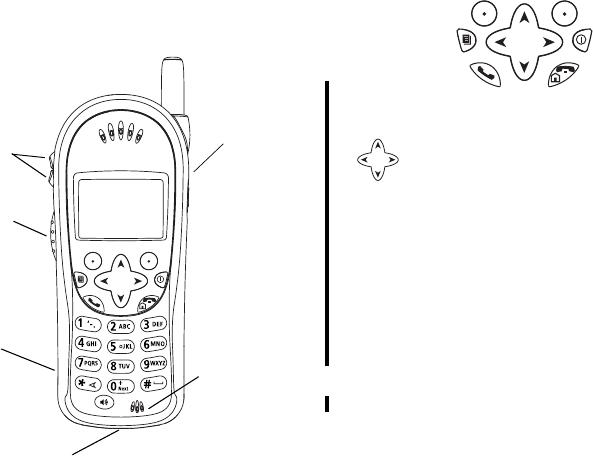
1
Getting Started
To start using your i205 phone:
•Make sure your SIM card is in place.
•Charge the battery.
•Activate your service.
•Start making calls and using your phone’s other
features.
audio jack
accessory connector
volume
controls
speaker
(in back)
Push-To-TalkTM
(PTTTM) button
microphone
pPower button.
Navigation key — press the arrows to scroll
through menus and list.
mAccesses context-sensitive menus.
ASelects the option appearing above it on
the display.
sSend key — places phone calls.
eEnd key — ends phone calls; returns to idle
screen.
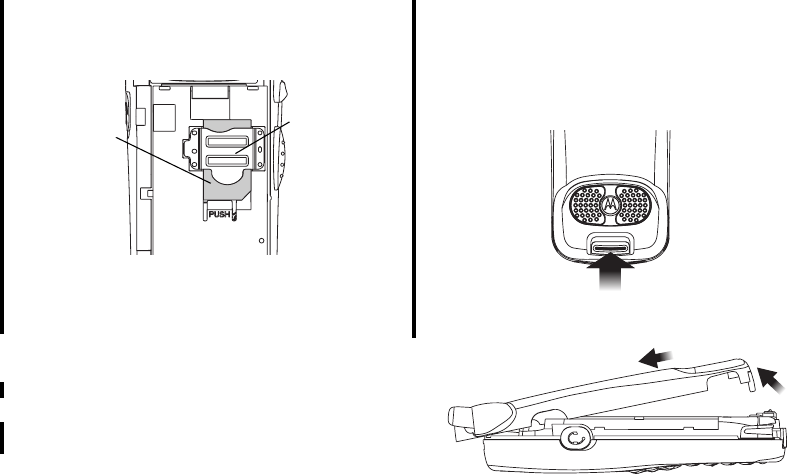
2
Getting Started
Locating Your SIM Card
Your SIM (Subscriber Identity Module) card is a small
piece of white plastic located in the SIM card holder
in the back of your phone, underneath the battery.
If your phone arrived with the battery on, remove it to
view your SIM card. See “Removing the Battery
Cover” on page 2.
If your SIM card is not in the SIM card holder, it may
be in the box your phone came in, attached to a piece
of white plastic about the size of a credit card. If this
is the case, carefully detach your SIM card from the
surrounding plastic and insert it as described in
“Inserting Your SIM Card” on page 12.
If there is no SIM card in your phone or the box,
contact your service provider.
Battery
Removing the Battery Cover
1Make sure the phone is powered off. See
“Powering On and Off” on page 5.
2Slide the release button forward until it releases
the battery cover.
3Remove the battery cover from the back of your
phone.
SIM card
holder
SIM card
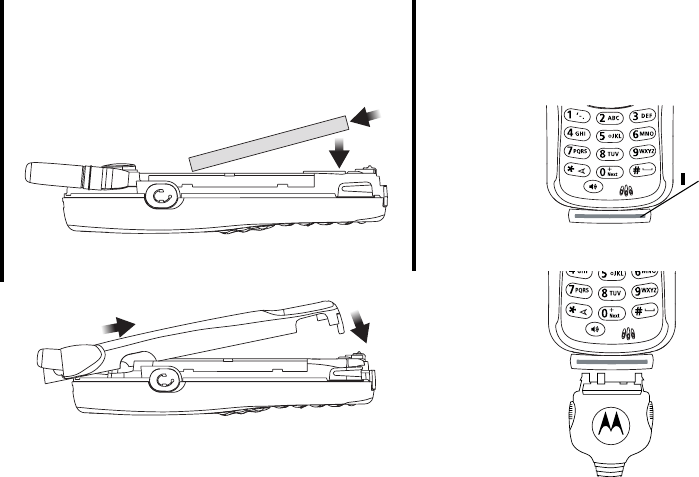
3
Battery
Inserting the Battery
1Remove the battery cover. See “Removing the
Battery Cover” on page 2.
2Insert the top of the battery into the battery area.
Press the bottom of the battery to secure it.
3Replace the battery cover and press it gently until
you hear a click.
Charging the Battery
Your phone comes with a battery charger.
1Plug the charger into an electrical outlet.
2Open the flap covering the phone’s accessory
connector.
3With the phone’s display facing up, plug the other
end of the charger into the accessory connector.
flap
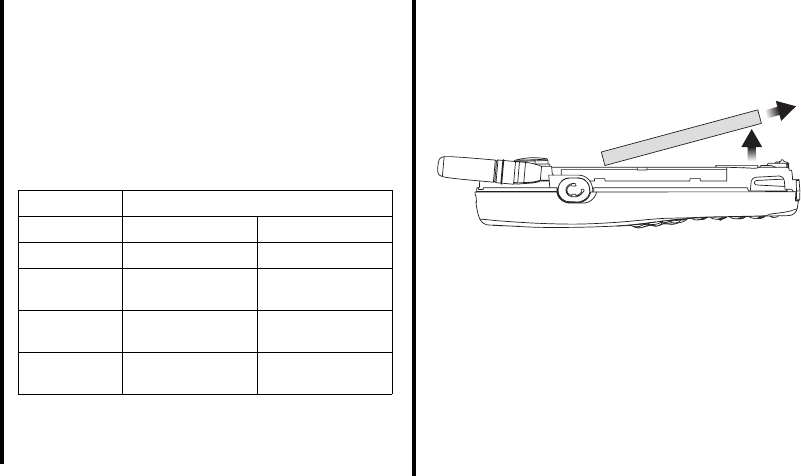
4
Getting Started
Tip: To remove the charger from the accessory
connector, press the buttons on the sides of
the plug.
4When charging the battery for the first time, charge
for 30 minutes longer than the time shown in
“ChargingTimes”onpage4.
Charging Times
See your battery and charger to determine the
appropriate charging time.
For best results, charge the batteries within the
temperature range of 10°C to 40°C (50°F to 104°F).
Prolonged charging is not recommended.
Removing the Battery
1Remove the battery cover. See “Removing the
Battery Cover” on page 2.
2Remove the battery by pushing the battery toward
the antenna and lifting it out.
Battery Use and Maintenance
•The Motorola iDEN Approved Lithium Ion chargers
provide optimum performance. Other chargers
may not fully charge the iDEN Lithium Ion battery
or may yield a reduced number of lifetime charge
cycles.
•Extreme temperatures degrade battery
performance. Do not store the battery where
temperatures exceed 60°C (140°F) or fall below
-20°C (4°F).
•Lithium Ion batteries have a self discharge rate
and without use, lose about 1% of their charge per
day.
Battery Charger
Rapid Mid-Rate
Slim 2 hours 4.5 hours
High
Performance 2hours 5hours
Extra
Capacity 2.5 hours 7 hours
Maximum
Capacity 3hours 8hours

5
Activating Service
•The battery capacity is degraded if the battery is
stored for long periods while fully charged. If long
term storage is required, store at half capacity.
Activating Service
The first time you power on your phone, you must be
in your local calling area. This activates your service.
See “Powering On and Off” on page 5 for information
on powering on your phone.
When you power on your phone for the first time,
enter 0000 if the Enter SIM PIN Code screen
appears. Press Aunder Ok.
You should change your SIM PIN code as soon as is
convenient. See “SIM Card Security” on page 10.
A screen may appear asking you to update your
browser information. Press Aunder Ok.See
“Over-the-Air Programming” on page 5.
Powering On and Off
To power your phone on:
1Extend the antenna.
2Press p.
3If the Enter SIM PIN Code screen appears, enter
your SIM PIN. See “Entering the PIN” on page 10.
Press Aunder Ok.
Note: When you receive your phone, the SIM PIN
is 0000. Change your PIN to prevent
fraudulent use of the SIM card (see
“Changing the PIN” on page 10).
As your phone connects to the network, you will
see a welcome message and a connecting
message. When the idle screen appears, the
phone is ready to use.
To power the phone off:
1Press and hold p.
2Push down the antenna.
Over-the-Air Programming
If you are set up to receive over-the-air programming
from your service provider, you must enable security
the first time you power on your phone or within 20
days of first activation of your phone:
1When you power on your phone for the first time,
after the idle screen appears, you will be prompted
to select Ok to update your browser information.
Note: If you press Aunder Later,youwillbe
prompted to enable security each time you
power on your phone until you press A
under Ok.
2Press Aunder Ok.
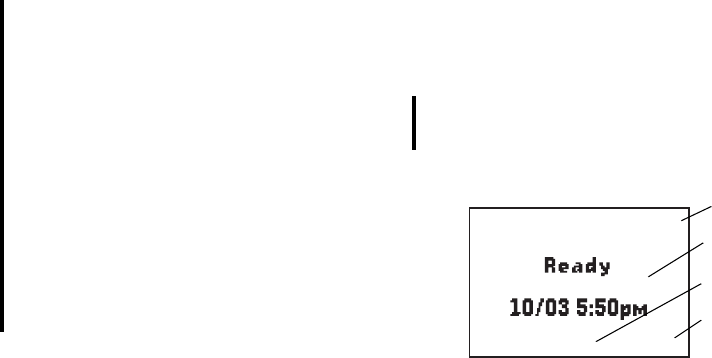
6
Getting Started
3You are prompted to enable security. Press A
under Yes. A series of screens appears. If you
subscribe to your service provider’s plan, your
home page appears.
4Press eto return to the idle screen.
Within 24 hours of enabling security, you will receive
a Net alert containing your Private ID and Talkgroup
lists for Private calls.
To accept programming:
1When you receive a Net alert saying New
Browser Message - Receive Programming Info,
press Aunder Goto.
2You are prompted to accept changes to your lists.
Press Aunder Ok.
3If you are prompted again to accept changes to
your lists, press Aunder Ok.
4A confirmation screen displays. Press Aunder Ok.
5Press eto return to the idle screen.
Making a Call
To make a phone call:
1Enter the number you want to call.
2Press sto place the call.
3Press eto end the call.
TomakeaPrivatecall:
1Enter the Private ID you want to call.
2Press and hold the PTT button on the side of your
phone. Begin talking after your phone emits a
chirping sound.
3ReleasethePTTbuttontolisten.
Phone Basics
Any time your phone is powered on, the display
provides you with information and options.
The screen shown above is the idle screen. The text
that appears of your idle screen depends on your
service provider. The idle screen appears when your
phone is on, but not engaged in any activity.
MesgContcs
sd1
S
status icons
text area
menu icon
display options

7
Phone Basics
Text Area
This area displays menus, messages, names, phone
numbers, and other information.
Display Options
Two display options appear at the bottom of most
screens. You select a display option by pressing the
option key below it.
Menus and Lists
Your phone’s features are arranged in menus,
submenus, and lists.
Toaccesstheitemsinamenuorlist,scrollusingthe
navigation key at the top of your keypad. This key lets
you scroll up, down, left, or right. Holding down the
appropriate part of the navigation key speeds up
scrolling.
In this guide, this symbol >tells you to select a menu
or list item. For example, Settings > Security
means:
1Scroll to Settings on the main menu.
2Press Aunder Select to see the Settings screen.
3Scroll to Security.
Menu Key
Many features provide context-sensitive menus that
let you access related features and actions. This icon
Sappears any time a context-sensitive menu is
available. Press mto access the menu.
Main Menu
All your phone’s features can be accessed through
the main menu. When you are using a feature, the
icon for that feature appears in the upper left corner
of the display.
aBrowser Browse the Web.
bSettings
Display/Info
Phone Calls
2-Way Radio
Volume
Security
Advanced
Customize your phone. See
page 79.
cVoiceRecord Record and play audio
messages. See page 61.
dContacts
new contact form
listofcontacts
Contacts menu
View,store,editcontacts.
Seepage25.

8
Getting Started
Status Icons
Status icons appear in the two rows at the top of the
display. Some appear at all times. Others appear
only when your phone is engaged in certain activities
or when you have activated certain features.
eMessages
Voice Mail
Text Msgs
etc.
Access and create
messages. See page 41.
fCall Forward Set call forwarding options.
See page 33.
gMemo Store a number to access
later. See page 73.
hCall Timers Phone usage information.
See page 69.
iRecent Calls
list of calls
recent calls menu
Call Setup menu
Lists recent calls. See
page 21.
jMy Info View personal phone
information, including phone
number and Private ID. See
page 13.
kCall Alerts
list of call alerts
Call Alerts menu
Lists call alerts. See
page 23.
lGPS Find your approximate
geographical location. See
page 51.
mRing Tones
list of ring tones
Ring Tones menu
Assign ring tones and turn
ringer off. See page 37.
abcd
efgd
Battery Strength —morebarsonthe
battery indicate a greater charge.
opq
rs Signal Strength — more bars next to the
antenna indicate a stronger signal.
APhone In Use — your phone is active on
a phone call.
BPrivate In Use — your phone is active on
aPrivatecall.
CTalkgroup In Use — your phone is active
on a group call.

9
Locking the Keypad
Locking the Keypad
Locking the phone’s keypad prevents its buttons from
being pressed. When the keypad is locked, you can
only:
•Power the phone on and off
•Unlock the keypad
•Respond to incoming calls, messages, and alerts
Important: Emergency calls cannot be placed while
the keypad is locked.
To lock the keypad:
1From the idle screen, press m.
2Press *.
If you press a key while the keypad is locked,
instructions for unlocking the keypad display briefly.
To unlock the keypad:
1From the idle screen, press m.
2Press *.
While the keypad is locked, you can respond to
incoming calls, messages, and alerts just as you do
when the keypad is not locked. When finished, press
eto return to the idle screen. The keypad remains
locked.
12 Active Phone Line — 1 indicates phone
line 1 is ready to make calls; 2 indicates
phone line 2 is ready to make calls.
GHI
JKL Call Forward — your phone is set to
forward calls. See “Call Forwarding” on
page 33.
MRinger Off — your phone is set not to
ring. See “Turning Ring Tones Off” on
page 37.
uSpeaker Off — your phone’s speaker is
off.
wy
x
Messages — you have one or more
messages. See “Messages” on page 41.
ijkl
mn T9 Text Input — you are using T9 Text
Input to enter text. See “Entering Text” on
page 75.
DEF Internet — you are ready to browse the
internet or are browsing the internet.
YZ Data cable — you are ready to transfer
data or are transferring data using a data
cable. See “Using Your Phone as a
Modem” on page 70.
NO TTY — see “Making TTY Calls” on page
71.

10
Getting Started
SIM Card Security
Your SIM card protects your personal information.
The SIM card stores all your Contacts information.
Since this information is stored on your SIM card, not
in your phone, you can remove the information by
removing your SIM card.
Note: Except for making emergency calls, your
phone will not function without the SIM card.
To prevent unauthorized use of your phone, your SIM
card is protected by a PIN that you enter each time
the phone is powered on. You can change the PIN or
turn off the requirement that it be entered.
Entering the PIN
You may be required to enter a SIM PIN when you
first use your phone.
When you receive your phone, the SIM PIN is 0000.
Change your PIN to prevent fraudulent use of the
SIM card. See “Changing the PIN” on page 10.
Important: If you enter your PIN incorrectly three
times, your SIM card is blocked. To
unblock your SIM card, you must contact
your service provider. See “Unblocking
the PIN” on page 11.
1When the Enter SIM PIN Code screen appears,
enter your SIM PIN. An asterisk appears for each
character entered.
2Press Aunder Ok.
Changing the PIN
1From the main menu, select Settings > Security >
Change Password > SIM PIN.
2At the Enter Old SIM PIN Code screen, enter the
current SIM PIN.
3Press Aunder Ok.
4At the Enter New SIM PIN Code screen, enter the
new 4 to 8-digit SIM PIN.
5Press Aunder Ok.
6At the Re-enter New SIM PIN Code screen,
re-enter the new SIM PIN to confirm.
7Press Aunder Ok.

11
SIM Card Security
Turning the PIN Requirement On and
Off
When the SIM PIN requirement is on, you are
prompted to enter your PIN each time you turn on
your phone.
Note: If a SIM PIN is required, your phone will not
function until the SIM PIN is entered, except
for making emergency calls.
When the PIN requirement is off, your phone can be
used without entering a PIN.
Important: When the SIM PIN requirement is off, the
personal data on your SIM card is not
protected. Anyone can use your phone
and access your personal data.
1From the main menu, select Settings > Security >
SIM PIN.
2Scroll to On or Off.
3Press Aunder Select.
4Enter the current SIM PIN.
5Press Aunder Ok.
Unblocking the PIN
If you enter your PIN incorrectly three times, your SIM
card is blocked. To unblock your SIM card, you must
contact your service provider to get a PIN Unblock
Code (PUK).
Important: If you unsuccessfully enter the PUK code
ten times, your SIM card is permanently
blocked and must be replaced. If this
happens, all data is lost. You will get a
message to contact your service provider.
Except for making emergency calls, your
phone will not function with a blocked SIM
card.
To unblock the PIN:
1Press **05s.
2Enter the PUK code.
3Press s.
4Enteranew4-to8-digitSIMPIN.Presss.
5Re-enter your SIM PIN. Press s.
If you entered the codes properly, SIM Unlocked
appears on the display.
Inserting and Removing Your SIM Card
Important: Do not touch the gold-colored areas of
your SIM card.
If you remove your SIM card and insert another SIM
card into your phone, the following information is
erased when you use your phone with the new SIM
card:
•The recent calls list
•Call forwarding settings
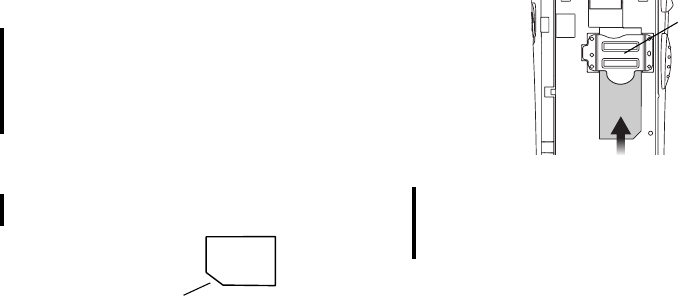
12
Getting Started
•Net alerts
•Mobile originated text messages, drafts, and quick
notes
•InformationstoredinMemo
•3 most recent GPS Enabled locations
•Voice records
•Voice names
Inserting Your SIM Card
1With your phone powered off, remove the battery
cover and battery. See “Removing the Battery” on
page 4.
2Hold your SIM card as shown. Do not touch the
gold-colored area.
3Carefully slide your SIM card to into your phone,
until it lies flat in the SIM card holder.
Removing Your SIM Card
Important: To avoid loss or damage, do not remove
your SIM card from your phone unless
absolutely necessary.
1With your phone powered off, remove the battery
cover and battery. See “Removing the Battery” on
page 4.
2Gently press the tab near the of the SIM card
holder.
cut corner
SIM card
holder
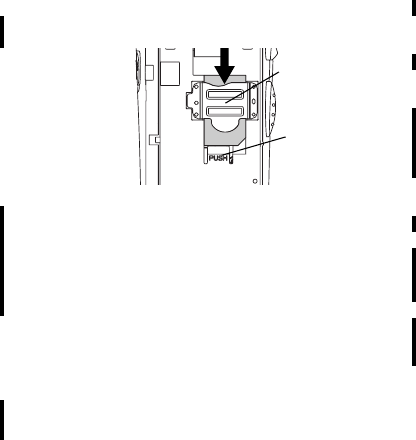
13
Completing Setup
3While holding the tab down, slide your SIM card
out of the SIM card holder. Do not touch the
gold-colored area.
Note: Protect your SIM card as you would any
delicate object. Store it carefully.
Completing Setup
My Info
My Info lets you view your phone number, Private ID,
and other phone information:
1From the main menu, select My Info.
2Scroll to see your information.
Some of this information is filled in automatically.
Some you enter.
•Name— Enter your name. See “Entering Text” on
page 75.
•Private— Your Private ID is the number that
others use to contact you using Private calls. It is
filled in when you receive your first Private call.
•Line1and Line 2 — Your phone numbers for
phone lines 1 and 2. Each is filled in when you
receive your first call on that line.
• Carrier IP — The IP address assigned to your
service provider. It is filled in when you register for
packet data services.
•IP1Addressand IP2 Address —TheIP
addresses you use to access the Internet with your
phone.
• Circuit Data Number (Ckt) — The number you
use if you want to use your phone as a modem.
You receive the number from your service
provider.
• Service Status — This information may be used
by your service provider if there is a problem with
your phone’s services.
Voice Mail and Other Messages
To receive voice mail, you must set up an account
with your service provider. See “Messages” on page
41 for information on using voice mail.
If your service provider offers mobile originated text
messaging, see “Mobile Originated Text Messaging”
on page 45 for information on setting up and using it.
tab
SIM card
holder

14
Getting Started
Customizing Features
You can control many features of your phone,
including the volume of incoming sound, rings, and
other tones. See “Customizing Your Phone” on page
79.
Accessories
Your phone comes with a battery and a charger.
To order additional accessories, log on to our Web
site at www.motorola.com/store/iden or contact your
Motorola Authorized Retailer.
For More Information
If you have questions about your i205 phone, contact
your sales representative or your service provider.

15
Making Calls
Your i205 phone makes two types of calls: digital
cellular phone calls and Private calls. With Private
calls, you use your phone as a long-range, digital
walkie-talkie.
To make a phone call:
1Enter the number you want to call.
2Press sto place the call.
3Press eto end the call.
To make a Private call:
1Enter the Private ID you want to call.
2Press and hold the PTT button on the side of your
phone. Begin talking after your phone emits a
chirping sound.
3ReleasethePTTbuttontolisten.
Receiving Calls
When you receive a phone call, your phone rings,
vibrates, or lights up its backlight.
To answer a phone call:
Press s.-or-
Press Aunder Yes.-or-
Press any key on the keypad.
To send a phone call to voice mail instead of
answering it:
Press e.-or-
Press Aunder No.
To end a phone call:
Press e.
When you receive a Private call, your phone emits a
chirping sound.
To answer a Private call:
1Wait for the caller to finish speaking.
2Press and hold the PTT button on the side of your
phone. Begin talking after your phone emits a
chirping sound.
3ReleasethePTTbuttontolisten.
Call Icons
When you make a call, call icons appear in text area
of the phone’s display.
WPlacing a phone call.
XReceiving a phone call.
YPhone call is active.

16
Making Calls
When you miss a call, this icon appears in text area:.
Entering the Number to Call
To enter the number you want to call, you can:
•Use the numbers on the keypad
•Select the number from the recent calls list
•Select the number from Contacts
•Redial the last phone number called
•Say a voice name into your phone
•Use Speed Dial or Turbo Dial make a phone call
•UseOneTouchPTTtomakeaPrivatecall
•Use a TTY device — see “Making TTY Calls” on
page 71
From the Keypad
To enter the number you want to call, press the
numbers on the keypad.
Ifyoumakeamistake:
•To clear a digit, press Aunder Delete.
•To clear all digits, press and hold Aunder Delete.
•To insert or delete a digit anywhere in the string of
digits you have entered, scroll left or right.
•To cancel, press e.
From the Recent Calls List
The recent calls list stores the last 20 calls you made
or received.
To select a number from the recent calls list as the
number you want to call:
1From the idle screen, press the down arrow on the
navigation key. -or-
From the main menu, select Recent Calls.
2Scroll to the name or number you want to call.
From Contacts
If you have numbers stored in Contacts, you can use
these numbers to make calls. For information on
entering numbers into Contacts, see “Creating
Entries” on page 27.
Calling from the Contacts List
1From the main menu, select Contacts.
2Scroll to the name or number you want to call.
ZPhone call is on hold.
UPhone call ended.
VMissed phone call.

17
Entering the Number to Call
Tip: To find Contacts entries faster, use the keypad
to enter the first letter of the name.
3Place the call now. -or-
Scroll left or right to view the icon for the number
you want to call.If an entry has more than one
number stored, <> surrounds the Contacts type
icon to the right of the entry.
If you are making a Private call, your phone places
thecalltothePrivateIDstoredintheContactsentry,
even if the Private ID icon is not displayed.
If you are making a phone call:
•Your phone places the call to the phone number
assigned to the Contacts type displayed.
•If the Contacts type displayed is not a phone
number, your phone places the call to the phone
number stored in the Contacts entry.
•If the Contacts type displayed is not a phone
number and you have more than one phone
number stored in the Contacts entry, your phone
prompts you to select the phone number you want
to place the call to.
Calling from a Contacts Entry
1From the main menu, select Contacts.
2Scroll to the name or number you want to call.
3Press Aunder View.-or-
If View is not one of your options: Press m. Select
View. Scroll to the number you want to call.
4Place the call now. -or-
Scroll to view more numbers. When you place the
call, it is made to the number displayed.
Redialing the Last Number
Press and hold sto place a call to the last phone
number you called.
Using a Voice Name
Note: This feature may not be offered by your
service provider.
If you have created a voice name in Contacts for the
number you want to call, say the voice name into
your phone to enter the number. See page 26 for
informationonvoicenames.
1Press and hold tuntil a prompt appears telling
you to say the voice name.
2Speaking into the microphone, say the voice name
assigned to the number you want to call.
Your phone plays the name back to you.
IfyouaremakingaPrivatecall,pressandholdthe
PTTbuttontoplacethecall.
If you are making a phone call, the call is placed
automatically.

18
Making Calls
Tip: To stop a phone call from being completed,
press e.
Using Speed Dial and Turbo Dial
Each phone number stored in Contacts is assigned a
Speed Dial number.
To use Speed Dial to enter the number you want to
call:
1From the idle screen, use the keypad to enter the
Speed Dial number assigned to the phone number
youwanttocall.
2Press #.
Turbo Dial lets you place calls to the phone numbers
associated with Speed Dial numbers 1 through 9
even more rapidly:
From the idle screen, press and hold the Speed
Dial number (1 through 9) assigned to the phone
number you want to call.
Using One Touch PTT
One Touch PTT sets your phone to call the most
recent Private ID on the recent calls list, or to a
Private ID you choose, every time you press the PTT
button. See “Setting One Touch PTT” on page 67.
Using Speakerphone
Note: Thisfeaturemaynotbeofferedbyyour
service provider.
Turning on speakerphone makes incoming sound
come out of the phone’s speaker instead of the
earpiece. Speakerphone is available whenever you
areonanactivecall.
To turn speakerphone on or off:
Press Aunder Speaker.-or-
Press t.
When speakerphone is on, Spkrphone On appears
in the text area of the display. When speakerphone is
off, this icon uappears.
Using Mute
Muting calls lets you listen to incoming sound without
transmitting sound. Mute is available whenever you
areonanactivecall.
To turn mute on:
Press Aunder Mute.
Whilemuteison,Unmute appears as a display
option.
To turn mute off:

19
Making Emergency Calls
Press Aunder Unmute.
Making Emergency Calls
Your phone supports emergency calling. Emergency
calls can be made even when your SIM card is
blocked or not in your phone.
Dial 911 to be connected to an emergency response
center. If you are on an active call, you must end it
before calling 911.
When you make an emergency call, your phone’s
GPS Enabled feature can help emergency service
personnel find you, if you are in a location where your
phone's GPS antenna has established a clear view of
the open sky and your local emergency response
center has the equipment to process location
information. See “GPS Enabled” on page 51, and
particularly “IMPORTANT: Things to Keep in Mind”
on page 51 and “Making an Emergency Call” on page
52, for more information on the limitations of this
feature. Because of the limitations of this feature,
always provide your best knowledge of your location
to the emergency response center when you make a
911 call.
Important: Emergency calls cannot be placed while
the keypad is locked.
Important: If you have not registered on the network,
emergency calls cannot be placed while
your SIM card is in your phone.
20
Making Calls

21
Recent Calls
The recent calls list stores the numbers of the 20
most recent calls you have made and received.
To view the recent calls list:
1From the idle screen, press the down arrow on the
navigation key. -or-
From the main menu, select Recent Calls.
2Scroll through the list.
If the number of a recent call is stored in Contacts,
the name associated with the number appears on the
recent calls list.
An icon appears beside the name or number
indicating the Contacts type of the number used in
the call. See “Contacts” on page 25.
For phone calls, an icon appears to the left of the
name or number giving more information about the
call:
Tip: The recent calls list also stores call alerts you
have received. They appears as Private calls.
To get more information on a recent call:
1From the recent calls list, scroll to the call you want
information on.
2Press Aunder View.-or-
If View is not one of your options: Press m. Select
to View.
This displays information such as the name
associated with the call, the number, the date, time,
and duration of the call.
Storing Recent Calls to
Contacts
1From the recent calls list, scroll to the call you want
to store.
2Press Aunder Store.-or-
If Store is not one of your options: Press m.Select
Store.
3To store the number as a new entry, press Aunder
Select.-or-
To store the number in an existing entry: Scroll to
the entry. Press Aunder Change.
WA call you made.
XA call you received.
VA missed call. Missed calls appear on the
recent calls list only if you have Caller ID.

22
Recent Calls
4Scroll left or right to the Contacts type you want to
assign the number.
5Press Aunder Select.
6If you want to add more information to the entry,
follow the applicable instructions in “Creating
Entries” on page 27.
7Press Aunder Done.
Deleting Recent Calls
Todeleteacall:
1From the recent calls list, scroll to the call you want
to delete.
2Press m.
3Select Delete.
4Press Aunder Yes to confirm.
To delete all calls:
1From the recent calls list, press m.
2Select Delete All.
3Press Aunder Yes to confirm.

23
Call Alerts
Sending a call alert lets the recipient know you want
to talk to him or her on a Private call.
When you send a call alert, the recipient’s phone
emits a series of beeps and displays your Private ID.
The recipient can:
•Answer — begin a Private call with the sender
•Queue — store the call alert to the call alert queue,
which is a list of call alerts
•Clear — dismiss and delete the call alert
Sending Call Alerts
1Enter the Private ID you want to send to, as you
wouldwhenmakingaPrivatecall.
2Press Aunder Alert.Ready to Alert appears on
the display.
3Press and hold the PTT button until Alert
Successful appears on the display.
Receiving Call Alerts
When you receive a call alert, you must answer,
queue, or clear it. You cannot receive phone calls or
Private calls until you do.
To answer a call alert, press the PTT button to
make a Private call to the sender.
To queue a call alert, press Aunder Queue.
To clear a call alert, press Aunder Clear.
Using the Call Alert Queue
When you queue a call alert, it remains in the call
alert queue until you respond to it, or delete it.
Viewing Call Alerts
1From the main menu, select Call Alerts.
2Scroll through the list.
Viewing Date and Time
To view the date and time a call alert was received:
1From the main menu, select Call Alerts.
2Scroll to the call alert you want information on.
3Press m.
4Select View.
Responding to Call Alerts in the Queue
After you queue a call alert, you can respond to it by
making a Private call to the sender or sending a call
alert to the sender. This call alert is then removed
from the queue.

24
Call Alerts
Making a Private Call to the Sender
1From the main menu, select Call Alerts.
2Scroll to the call alert you want to respond to.
3Press and hold the PTT button to begin the call.
Sending a Call Alert to the Sender
1From the main menu, select Call Alerts.
2Scroll to the call alert you want to respond to.
3Press Aunder Alert.Ready to Alert appears on
the display.
4Press and hold the PTT button until Alert
Successful appears on the display.
Deleting Call Alerts
To delete a call alert from the queue:
1From the call alert queue, scroll to the call alert you
want to delete.
2Press m.
3Select Delete.
4Press Aunder Yes to confirm.
To delete all call alerts from the queue:
1From the call alert queue, press m.
2From the call alert menu, select Delete All.
3Press Aunder Yes to confirm.
Sorting Call Alerts
To sort call alerts by the order they were received:
1From the main menu, select Call Alerts.
2Press m.
3Select Sort By.
4Scroll to First on Top or Last on Top.
5Press Aunder Select.

25
Contacts
Contacts stores up to 600 numbers or addresses.
Each Contacts entry can store several numbers or
addresses.
InformationstoredinContactsissavedonyourSIM
card. If you move your SIM card to another
SIM-based Motorola phone, you can access
information stored in Contacts from that phone.
A Contacts entry contains:
•A name — A name is required if your are storing
more than one number or address to the entry;
otherwise, it is optional. Typically, this is the name
of the person whose contact information is stored
in the entry.
•Aringtone—Youcanassignaringtonetoring
whenyougetcallsfromthepersonwhosecontact
information is stored in the entry.
•A number or address — Each Contacts entry must
contain a number or address. This may be any
type of phone number, Private ID, Talkgroup
number, email address, or IP address.
•A Contacts type — Each number or address stored
must be assigned a Contacts type:
•A Speed Dial number — When you store a phone
number, it is assigned a Speed Dial number. You
can accept the default Speed Dial number or
change it.
AMobile phone number
BPrivate Private ID
CWork1 phone number
DWork2 phone number
EHome phone number
Femail email address
GFax phone number
HPager phone number
ITalkgroup Talkgroup number
JIP IP address
KOther phone number

26
Contacts
•A voice name — If you create a voice name for a
number, you can then dial that number by saying
the voice name into your phone. This icon appears
Pto the left of the Contacts type icon if a voice
name is assigned.
Note: This feature may not be offered by your
service provider.
Viewing Contacts
To access Contacts:
From the main menu, select Contacts.-or-
Press Aunder Contcs.-or-
Ifyouareonacall:Pressm. Select Contacts.
To view entries:
1From the Contacts list, scroll to the entry you want
to view.
2If an entry has more than one number or address
stored, <> surrounds the Contacts type icon to
the right of the entry. Scroll left or right to view icon
foreachnumberstoredintheentry.
3When the icon for the number or address you want
to view is displayed, press Aunder View.-or-
If View is not one of your options: Press m.Scroll
to View.PressAunder Select.
4Scroll to view the other numbers and addresses
stored for the entry.
Tip: To view more entries, keep scrolling.
Searching for a Name
To search for a name in Contacts:
1From the Contacts list, press m.
2Select Search.
3Enter the name you want to see. See “Entering
Text” on page 75.
4Press Aunder Ok.
Your phone finds the name you entered or the
nearest match.
Showing Only Private IDs and
Talkgroups
To set Contacts to show only entries that contain
Private IDs and Talkgroup entries:
1From the Contacts list, press m.
2Select Filter.
3With Show Prvt/Grp highlighted, press Aunder
Select.
To set Contacts to show all entries:
1From the Contacts list, press m.
2Select Filter.

27
Creating Entries
3Scroll to Show All.
4Press Aunder Select.
Creating Entries
A number or address and a Contacts type are
required for all Contacts entries. Other information is
optional. You may enter the information in any order
by scrolling through the entry details.
After you have entered the number or address,
Contacts type, and any other information you want,
you can press Aunder Done to save the entry to
Contacts.
To cancel a Contacts entry at any time press, eto
return to the idle screen.
Tip: In some fields that require you to enter
information, you can begin entering the
information from the keypad instead of
pressing Aunder Change.
To create a Contacts entry:
1To access the entry details screen:
Select Contacts > [New Contact].-or-
From the Contacts list, press m.ScrolltoNew.
Press Aunder Select.
2Ifyouwanttoassignanametotheentry:
With the Name field highlighted, press Aunder
Change.
Enter the name. See “Entering Text” on page 75.
When you are finished, press Aunder Ok.
3If you want to assign a ring tone to the name:
With the Ringer field highlighted, press Aunder
Change.
Scrolltotheringtoyouwanttoassign.
Press Aunder Ok.
4To assign a Contacts type to the number or
address being stored:
With the Contacts type field highlighted, press A
under Change.
Scroll to the Contacts type you want to assign.
Press Aunder Select.
5To store a number or address:
With the #(or ID for an email address, or IP an IP
address) field highlighted, press Aunder Change.
Enter the number or address. For phone numbers,
use the 10-digit format. For email addresses, see
“Entering Text” on page 75.
When you are finished, press Aunder Ok.

28
Contacts
6Ifyouwantassignmoreoptionstothenumber,
press Aunder Change with the [Options] field
highlighted. See “Assigning Options” on page 28.
7If you want to add more numbers or addresses to
the entry:
Scroll past the information you already entered.
Enter the additional information for the number
using step 2 through step 6. You must assign a
name to the entry, if you have not already.
8Press Aunder Done.
Assigning Options
1If you have not already, press Aunder Change
with the [Options] field highlighted
2The default Speed Dial number assigned to a
phone number is displayed in the Speed # field.
This is always the next available Speed Dial
location.
If you want to assign the phone number to a
different Speed Dial location:
With the Speed # field highlighted, press Aunder
Change.
Press Aunder Delete to delete the current Speed
Dial number.
Enter the new Speed Dial number using the
keypad.
When you are finished, press Aunder Ok.
3If you want to create a voice name for a phone
number:
With the Voice Name field highlighted, press A
under Record.
As directed by the screen prompts, say and repeat
the name you want to assign to the number. Speak
clearly into the microphone.
4When you are finished assigned options, press A
under Back.
Storing Numbers Faster
To store numbers to Contacts from the recent call list,
see “Storing Recent Calls to Contacts” on page 21.
To store numbers to Contacts from Memo, see
“Memo” on page 73.
To store numbers to Contacts from the idle screen:
1Use the keypad to enter the number you want to
store.
2Press m.
3Select Store Number.
4To store the number as a new entry, press Aunder
Select.-or-
To store the number in an existing entry: Scroll to
the entry. Press Aunder Select.

29
Editing Entries
5Scroll left or right to the Contacts type you want to
assign the number.
6Press Aunder Select.
7Press Aunder Done.
Editing Entries
1From the Contacts list, scroll to the entry you want
to edit.
2Press m.
3Select Edit. The entry details screen displays.
4Follow the applicable instructions in “Creating
Entries” on page 27 to edit the various fields.
Deleting Entries
Delete an Entry
1From the Contacts list, scroll to the entry you want
to delete.
2Press m.
3To delete the entire entry, scroll to Delete Contact.
4Press Aunder Select.
5Press Aunder Yes to confirm.
Delete a Number or Address
1From the Contacts list, scroll to the entry that
contains the number or address you want to
delete.
2Press m.
3Scroll to display the number you want to delete.
4Scroll to Delete Number.
5Press Aunder Select.
6Press Aunder Yes to confirm.
Deleting All Entries From Contacts
1From the Contacts list, press m.
2Scroll to Delete All.
3Press Aunder Select.
4Press Aunder Yes to confirm.
Checking Capacity
To see how many numbers are stored in Contacts:
1From the Contacts list, press m.
2Select Capacity.

30
Contacts
Creating Pauses and Waits
When storing a number, you can program your phone
to pause or wait between digits while dialing. A pause
makes your phone pause for 3 seconds before
dialing further. A wait makes your phone wait for your
response before dialing further.
This feature is useful when using voice mail or other
automated phone systems that require you to dial a
phone number and then enter an access number.
To program a pause:
Press and hold *until the letter P appears. The P
represents a 3-second pause.
If you store 17035551235P1234, when you select
this number and make a call, your phone dials the
first 11 digits, pauses for 3 seconds, then dials the
last 4 digits.
If you want a pause longer than 3 seconds, press and
hold *more than once. Each P represents a
3-second pause.
To program a wait:
Press and hold *until the letter W appears. The
W means your phone waits here before dialing
further.
If you store 17035551235W1234, when you select
this number and make a call, your phone dials the
first 11 digits and then waits. A message appears
asking it you want to send the rest of the digits. Press
Aunder Yes to dial the last 4 digits.
Tip: You can create pauses and waits while dialing
a number from the keypad. See “Creating
Pauses and Waits While Dialing” on page 67.
International Numbers
When storing number that you plan to use for
international calls, use Plus Dialing:
1Press and hold 0fortwoseconds.A“0”appears,
then changes to a “+”.
Note: The network translates the “+” into the
appropriate international access code
needed to place the call.
2Enter the country code, city code, or area code,
and phone number.

31
Accessing Contacts with GSM Phones
Accessing Contacts with GSM
Phones
If you plan to use the information stored in Contacts
with an i2000, i2000plus, or any other GSM phone,
you must purchase CompanionPro. Go to
www.motorola.com/iden or your service provider’s
web site for more information.
You can use CompanionPro to make the Contacts
information saved to your i205 phone’s SIM card
accessible in this type of phone.
32
Contacts

33
Call Forwarding
Call forwarding sends calls to the phone numbers
you specify. You can forward all calls to one number
or forward missed calls to different numbers
depending on the reason you missed the call.
You can forward phone lines 1 and 2 independently.
Forwarding All Calls
When you set your phone to forward all calls, an icon
appears in the top row of the display:
All your calls are forwarded to the same number.
To forward all calls:
1From the main menu, select Call Forward.
2Press Aunder Change.
3Select All Calls.
4Scroll to To.
5Press Aunder Change.
6If you specified a forwarding number for all calls
before, this number displays. Press Aunder
Change.
To forward calls to this number, press Aunder Ok.
-or-
To delete to this number, press and hold Aunder
Delete.
7To enter the number you want to forward calls to:
Enter the number using your keypad. -or-
Press Aunder Search.SelectContacts,Recent
Calls,orMemo. Enter the number from Contacts,
the Recent Calls list, or Memo, as you would when
making a call.
8Press Aunder Ok.
All your calls are now forwarded to the number you
specified.
GPhone line 1 is active; calls to phone line 1 are
being forwarded.
HPhone line 1 is active; calls to phone line 2 are
being forwarded.
IPhone line 1 is active; calls to phone lines 1 and
2 are being forwarded.
JPhone line 2 is active; calls to phone line 1 are
being forwarded.
KPhone line 2 is active; calls to phone line 2 are
being forwarded.
LPhone line 2 is active; calls to phone lines 1 and
2 are being forwarded.

34
Call Forwarding
Tip: In some fields, you can select an option by
scrolling left or right instead of pressing A
under Change.
Turning Off Call Forwarding
If you don’t want all your calls forwarded, turn the
feature off:
1From the main menu, select Call Forward.
2Press Aunder Change.
3Select All Calls.
4Scroll to To.
5Press Aunder Change.
6Scroll to Off.
7Press Aunder Select.
All your calls are now sent to your phone.
Calls you miss are forwarded according to the
options set for missed calls. By default, missed calls
are forwarded to voice mail.
Forwarding Missed Calls
You can specify a forwarding number to each type of
missed call:
•IfBusy— Your phone is on a call or transferring
data.
•IfNoAnswer— You do not answer on the first 4
rings.
• If Unreachable — Your phone is out of coverage
or powered off.
Note: If you want a type of missed calls sent to
voice mail, the call forwarding number for
that type of missed calls must be your voice
mail access number.
To forward missed calls:
1From the main menu, select Call Forward.
2Press Aunder Change.
3Select Detailed.
4Scroll to If Busy to specify a forwarding number for
calls received when your phone is busy.
5Press Aunder Change.
6If you specified a forwarding number for this type
of calls before, this number displays. Press A
under Change.
To forward calls to this number, press Aunder Ok
andgotostep9.-or-
To delete to this number, press and hold Aunder
Delete.
7To enter the number you want to forward this type
of calls to:
Enter the number using your keypad. -or-
36
Call Forwarding

37
Ring Tones
To set the ring tone your phone makes when you
receive phone calls, message notifications, or call
alerts:
1From the main menu, select Ring Tones.
2Make sure Vibrate All or SilentAll is set to Off.
3Scroll through the list of ring tones to the one you
want to assign. Highlighting a ring tone lets you
hear it.
4Press Aunder Assign.
5Scroll to the feature you want to assign the ring
tone to.
6Press Aunder Select.
Tip: A checkmark next to a feature means the
current ring tone has been assign to it. To
remove the assignment: Scroll to the feature.
Press Aunder Select.
7To assign the ring tone to other features, repeat
step 5 through step 6.
8When you are finished, press Aunder Done.
To hear the ring tone you have selected:
Press the volume keys on the side of your phone.
TurningRingTonesOff
You can set your phone to make no sound when you
receive all phone calls, Private calls and group calls,
messages notifications, and call alerts. If your phone
includes the vibrate feature, this sets your phone to
vibrate instead of making a sound.
1From the main menu, select Ring Tones > Vibrate
All.
2Scroll left or right to set Vibrate All to On.
Note: This feature may not be offered by your
service provider.
If your phone does not include a vibrate feature, you
canstillsetittomakenosound:
1From the main menu, select Ring Tones >
SilentAll.
2Scroll left or right to set SilentAll to On.
This icon Mappears in the upper right of your
display.
To set your phone to make no sound for some
features but not others:
1From the main menu, select Ring Tones.
2Make sure Vibrate All or SilentAll is set to Off.
3Scroll through the list of ring tones to Vibrate or
Silent.
4Press Aunder Assign.

38
Ring Tones
5Scroll to the feature you want to set to make no
sound.
Note: To set ring options for Private calls and
group calls, see “Setting Your Phone to Not
Ring” on page 79.
6Press Aunder Select.
7To assign Vibrate or Silent to another feature,
repeat step 5 through step 6.
8When you are finished, press Aunder Done.
Assigning Ring Tones to
Contacts
You can set the ring tone your phone makes when
you receive phone calls, message notifications, or
call alerts from someone you have stored in
Contacts.
1From the main menu, select Ring Tones.
2Make sure Vibrate All or SilentAll is set to Off.
3Scroll through the list of ring tones to the one you
want to assign. Highlighting a ring tone lets you
hear it.
4Press Aunder Assign.
5Select AContact.
6Scroll to the Contacts entry to want to assign the
ring tone to.
7Press Aunder Select.
Viewing Ring Tone
Assignments
1From the main menu, select Ring Tones.
2Press m.
3Select Overview.
4Scroll to view ring tones assigned to features and
Contact entries.
Downloading More Ring Tones
If you want to use other ring tones, you can download
them into your phone. Go to
www.motorola.com/idenupdate for a selection of
custom ring tones and downloading instructions.
Note: Ring tones purchase from this web site may
be downloaded only once. If you delete a
ring tone from your phone, you must
purchase it again to download it again.
Managing Memory
To view the amount of memory available for custom
ring tones:
1From the main menu, select Ring Tones.
2Press m.

39
Deleting Custom Ring Tones
3Select Memory Usage.
Deleting custom ring tones frees memory.
Note: Ring tones are stored in your phone using
thesamememoryspaceusedtostorevoice
records(see“VoiceRecords”onpage61),
Deleting voice records frees memory space
for ring tones.
Deleting Custom Ring Tones
To delete a custom ring tone:
1From the main menu, select Ring Tones.
2Scroll to the ring tone you want to delete.
3Press m.
4Select Delete.
5Press Aunder Yes to confirm.
40
Ring Tones

41
Messages
To access your voice mail messages, text and
numeric messages, Net alerts, and any other types of
messages you are able to receive, go to the message
center:
1From the main menu, select Messages.-or-
Press Aunder Mesg.
2Scrolltothetypeofmessageyouwanttoaccess.
3Press Aunder the display option on the left.
The message center shows how many messages
you have of each type. You can listen to, read, or
delete these messages.
Message Notifications
When you receive a message, your phone notifies
you with text on the display and a notification tone.
You can access the message or dismiss the
notification.
If you dismiss the notification, the message is not
deleted. It can be accessed through the message
center.
Ifyouarenotonaphonecallwhenyoureceivea
message, your phone sounds a notification tone
every 30 seconds until you access the message or
dismiss the alert.
If you are on a call when you receive a message,
your phone may sound a notification tone during the
call or after you end the call, depending on how you
set your notification options.
Setting Notification Options
To control whether your phone sounds message
notification tones while you are on phone calls:
1From the main menu, select Settings > Phone
Calls > Notifications.
2Choosetheoptionyouwant:
• Receive All — Tones sound during calls for all
types of messages.
• Msg Mail Only — Tones sound during calls for
mail messages; tones for all other types of
messages are held until you end calls.
• Delay All — Tones for all types of messages are
held until you end calls.
3Press Aunder Select.
Tip: To set notifications options during a call: Press
m.SelectNotifications.
Voice Mail
Note: To receive voice mail messages, you must
first set up a voice mail account with your
service provider.

42
Messages
When you receive a voice mail message, New Voice
Mail Message appears on the display.
To call your service provider’s voice mail system and
listen to the message:
Press Aunder Call.
To dismiss the message notification:
Press Aunder Exit.Thisiconyappears on the
display,remindingyouthatyouhaveanew
message.
Sending Unanswered Calls to Voice
Mail
To send a phone call to voice mail instead of
answering it:
Press Aunder No.
If the caller leaves a message, this icon yappears
on the display, reminding you that you have a new
message.
Text and Numeric Messages
The phone’s display refers to text and numeric
messages as Text Messages.
These messages can be up to 140 letters or 20 digits
long. You can store up to 16 of these messages.
Each message is stamped with the date and time it
was left.
If your phone is powered off when you receive a
messages, your phone notifies you when it is next
powered. If you are out of your coverage area, your
phone alerts you when you return to your coverage
area.
Your phone attempts to deliver these messages for
up to 7 days.
Tip: While reading a text and numeric message
that contains a phone number, you can press
sto call that number.
Receiving a Message
When you receive a text and numeric message, New
Text Message appears on the display.
To view the message:
1Press Aunder Read.
2If the message fills more than one screen, scroll to
read it.
3To keep the message, press Aunder Save.-or-
To delete the message, press Aunder Delete.
To dismiss the message notification:

43
Net Alerts
Press Aunder Exit.ThisiconAappears on the
display,remindingyouthatyouhaveanew
message.
Reading From the Message Center
1From the message center, select Text Msgs.
2Scroll to the message you want to read.
3Press Aunder Read.
4If the message fills more than one screen, scroll to
read it.
5To keep the message, press Aunder Save.-or-
To delete the message, press Aunder Delete.
Net Alerts
Note: This feature may not be offered by your
service provider.
Net alerts are text and numeric messages sent form:
•Your i205 phone
•A web site provided by your service provider
•Any email application
When you receive a Net alert, a notification appears
on the display.
If you dismiss the notification, this icon Aappears
on the display, reminding you that you have a new
message.
44
Messages

45
Mobile Originated Text
Messaging
With mobile originated text messaging, you can send
and receive short text messages to and from other
iDEN phones. Messages you receive appear on your
phone’s display and in the text message inbox. You
access these messages through the message center.
See“Messages”onpage41.
Note: This feature may not be offered by your
service provider.
Setting Up
Before you begin using mobile originated text
messaging, you must set up your signature, service
center number, and expiration information:
1From the main menu, select Messages > Text
Inbox.
2Press m.
3Select Text Msg Setup.
4With the Signature field highlighted, press A
under Change.
Enter your signature. It may be up to 11 characters
long. See “Entering Text” on page 75. When you
are finished, press Aunder Ok.
5With the Srvc Cntr No field highlighted, press A
under Change.
Enter the phone number of your service center. If
you do not know this number, contact your service
provider.
Note: Youmustusethe“+”dialingcodeand
country code as part of the service center
number. If the service center number is not
preceded by a “+” sign and country code,
the message will not be sent successfully.
The network returns an error message to
your phone.
When you are finished, press Aunder Ok.
6With the Expire After field highlighted, press A
under Change.
This is the amount of time messages you send are
saved if they cannot be delivered. After this period,
they are discarded.
Scroll or press Aunder Qto change field.
When you are finished, press Aunder Done.
7Press Aunder Back to save the information you
entered.

46
Mobile Originated Text Messaging
Receiving Messages
When you receive a message, your phone notifies
you as it would with any other type of message. See
“Message Notifications” on page 41.
To view the message:
Press Aunder Read.
To dismiss the message notification:
Press Aunder Exit.
Reading Messages From the
Message Center
1From the main menu, select Message > Text
Inbox.
2Scroll to the message you want to read.
3Press Aunder Read.
4If the message fills more than one screen, scroll to
read it.
5To keep the message, press Aunder Save.-or-
To delete the message, press Aunder Delete.
Tip: To see more choices, including replying to the
message, press m.
Your text inbox holds up to 16 messages. Each
message can be up to 160 characters long.
Creating and Sending
Messages
1From the main menu, select Messages > Text
Inbox > [Create Msg].-or-
From the main menu, select Messages > Text
Outbox > [Create Msg].
2Press Aunder Create.
3To address the message:
Use the keypad to enter the phone number of the
person you want to send the message to. -or-
Press Aunder Browse. Select Contacts,Recent
Calls,orMemo. Enter the number from Contacts,
the recent calls list, or Memo, as you would when
makingacall.
When you are finished, press Aunder Ok.
4Enter the text of the message. See “Entering Text”
on page 75. -or-
To use a quick note: Press Aunder Browse.
Scroll to the quick note you want. Press Aunder
Select.
If you want to add your signature: Press m. Select
Add Signature.
When you are finished, press Aunder Ok.

47
Creating and Sending Messages
5If you want to send the message, press Aunder
Yes.-or-
If you want to request confirmation of delivery,
specify the type of messages you want to send,
save the message as a draft, or delete the
message without sending it, press Aunder No.
6If you want to request confirmation of delivery:
With the Report field highlighted, press Aunder
Change. Select Yes.
7If you want to specify the type of messages you
want to send:
With the Send As field highlighted, press Aunder
Change. Scroll to the message type you want.
Press Aunder Select.
8To send the message: Press s.PressAunder
Yes.-or-
To save the message as a draft without sending it:
Press m.ScrolltoSave As Draft.PressAunder
Select.-or-
To delete the message without sending it: Press
m.ScrolltoDelete.PressAunder Select.
Tip: In some fields, you can select an option by
scrolling left or right instead of pressing A
under Change.
Using Quick Notes
Quick notes are short, pre-written text messages that
youcancreate,edit,andsend.Youcanstoreupto
20 quick notes. A quick note may be up 30 characters
long.
To create a quick note:
1From the main menu, select Messages > Quick
Notes > [New Quick Note].
2Press Aunder Create.
Enter text. See “Entering Text” on page 75. -or-
To choose from pre-installed notes: Press Aunder
Browse. Scroll to the note you want. Press A
under Select.
3Press Aunder Store.
Tip: For more options, including sending the quick
note, press m.
Using Drafts
When you save a message as a draft, it is saved in
thedraftsfolder.Youmusthaveadraftsavedtohave
a drafts folder.
To edit a draft:
1From the main menu, select Messages > Drafts
Folder.
2Press Aunder Change.

48
Mobile Originated Text Messaging
3To edit the fields you want to change, follow step 3
through step 8 in “Creating and Sending
Messages” on page 46.
If you have a draft saved, you can create more drafts
in the drafts folder:
1From the main menu, select Messages > Drafts
Folder > [Create Msg].
2Press Aunder Create.
3Followstep3throughstep7in“Creatingand
Sending Messages” on page 46.
4Scroll to Save As Draft.
Using the Outbox
Messages you have sent are stored in the outbox.
These icons appear next to messages in the outbox:
Resending Messages
To resend a message:
1From the main menu, select Messages > Text
Outbox.
2Scrolltothemessageyouwanttoresend.
3Press m.
4Select Re-send.
5Press Aunder Yes to confirm.
Deleting Sent Messages
To delete a sent message:
1From the main menu, select Messages > Text
Outbox.
2Scroll to the message you want to delete.
3Press m.
4Select Delete.
5Press Aunder Yes to confirm.
To delete all unlocked sent messages:
1From the main menu, select Messages > Text
Outbox.
2Press m.
4Sent and confirmed.
9Send attempted.
0Forwarded.
5Received by addressee.
6Not received by addressee.
8Send failed.
7Re-sent.
RLocked.

49
Managing Memory
3Select Delete All.
4Press Aunder Yes to confirm.
Locking Sent Messages
When you lock a message, it cannot be deleted until
you unlock it.
1From the main menu, select Messages > Text
Outbox.
2Scroll to the message you want to lock or unlock.
3Press m.
4Scroll to Lock to lock the message. -or-
Scroll to Unlock to unlock the message.
5Press Aunder Select.
Managing Memory
Your text inbox, outbox, and drafts folder have a set
amount of memory available for storing message.
The text inbox holds 16 messages of up to 160
characters. If the text inbox is full, you cannot receive
messages until you delete some.
The outbox and drafts folder share memory space.
Together they can hold 20 messages. If the outbox
and drafts folder memory is full, you cannot send
messages or save drafts until you delete some.
To view the amount of memory available in your text
inbox:
1From the main menu, select Messages > Text
Inbox.
2Press m.
3Select Memory Meter.
To view the amount of memory available in your
outbox and drafts folder:
1From the main menu, select Messages > Text
Outbox.
2Press m.
3Select Memory Meter.
50
Mobile Originated Text Messaging

51
GPS Enabled
Your phone’s GPS Enabled feature uses information
from Global Positioning System (GPS) satellites
orbiting the Earth to determine the approximate
geographical location of your phone, expressed as
latitude and longitude. The availability and accuracy
of this location information (and the amount of time
that it takes to calculate it) will vary depending on the
environment in which you are using the GPS feature.
For example, GPS location fixes are often difficult to
obtain indoors, in covered locations, between high
buildings, or in other situations where you have not
established a clear broad view of the sky. SEE:
“IMPORTANT: Things to Keep in Mind” on page
51.
When you make a 911 emergency call, the GPS
feature of your phone can help emergency personnel
locate you if your phone has adequate access to
GPS satellite signals and your emergency response
center is equipped to process such information.
You can also use the GPS feature to view your
approximate location. Location information appears
on the phone’s display.
Java applications loaded on your phone can also
request your location. If your phone is connected to a
laptop computer or similar device, software running
on that device can request your location. To protect
your privacy, you can control whether these requests
are granted.
IMPORTANT: Things to Keep in
Mind
If you are using the GPS feature of your phone while
driving, please give full attention to driving and to the
road.
Where adequate signals from multiple satellites
are not available (usually because your GPS
antenna cannot establish a view of a wide area of
open sky), the GPS feature of your phone WILL
NOT WORK. Such situations include but are not
limited to:
• In underground locations
• Inside of buildings, trains, or other covered
vehicles
• Under any other metal or concrete roof or
structure
• Between tall buildings or under dense
tree-cover
• Near a powerful radio or television tower

52
GPS Enabled
• When your GPS antenna is covered (for
example, by your hand or other object) or
facing the ground
• In temperature extremes outside the operating
limits of your phone
Walking or driving very slowly may also
substantially reduce GPS performance.
Even where location information can be
calculated in such situations, it may take much
longer to do so, and your location estimate may
not be as accurate. Therefore, in any 911 call,
always report the location to the emergency
response center if you can and if you cannot,
remain on your phone for as long as the
emergency response center instructs you.
Even where adequate signals from multiple
satellites are available, your GPS feature will only
provide an approximate location, often within 150
feet (45 meters) but sometimes much further from
your actual location. Advice on how to improve
GPS performance is provided in “Enhancing GPS
Performance” on page 54.
While the GPS feature of your phone can be a
valuable navigational aid, it does not replace the
need for careful navigating and good judgment.
Never rely solely on one device for navigation.
Remember that the accuracy of the location
informationandthetimeneededtoobtainitwillvary
depending on circumstances, particularly the ability
to receive signals from adequate numbers of
satellites.
On emergency calls, your phone uses assistance
information from the phone network to improve the
speed and accuracy of your phone’s location
calculation: if such assistance information becomes
unavailable, it may reduce the speed and accuracy of
the location calculation.
The satellites used by the GPS feature of your phone
are controlled by the U.S. government and are
subject to changes implemented in accordance with
the Department of Defense GPS user policy and the
Federal Radionavigation Plan. These changes may
affect the performance of the GPS feature of your
phone.
Making an Emergency Call
Dial 911 to be connected to an emergency response
center. If you are on an active call, you must end it
before calling 911.
When you make an emergency 911 call, the GPS
feature of your phone begins to seek information to
calculate your approximate location. It will take the
GPS feature of your phone some time to
determine your approximate location. Even where
your phone has good access to sufficient GPS

53
Viewing Your Approximate Location
satellite signals and network assist data, it may take
30 seconds or more to determine the approximate
location. This time will increase where there is
reduced access to satellite signals. When your
approximate location is determined, it is made
available to the appropriate emergency response
center.
In some cases, your local 911 emergency
response center may not be equipped to receive
GPS location information. For this reason, and
because the GPS location information reported is
only approximate or may not be available in your
location (see “IMPORTANT: Things to Keep in Mind”
on page 51), always report your location to the
911 operator you speak to when making an
emergency call, if able, just as you would when using
a phone without GPS capabilities.
Note: If you are concerned about whether your
local 911 emergency response center is
equipped to receive GPS location
information, contact your local authorities.
In general, if your phone has access to signals from
more GPS satellites, your location will be determined
faster and more accurately than if your phone has
access to signals from fewer GPS satellites.
If your phone does not have adequate access to GPS
satellites signals, the location of the nearest cell
tower in contact with your phone is automatically
made available to the emergency response center, if
the center has the capability to receive such
information.
See “Enhancing GPS Performance” on page 54 for
information on how to help your phone determine
your location.
Viewing Your Approximate
Location
1From the main menu, select GPS > Position.
2Scroll to view the entire screen.
This displays the following information about the last
time your location was calculated:
•Thetime(asGreenwichMeanTime)anddatethat
the location was last calculated
•The approximate location, expressed as latitude
and longitude
•The estimated accuracy of the calculated location.
This estimate of accuracy is only a very rough
estimate and may vary substantially from the
actual accuracy of the approximate location
information reported.

54
GPS Enabled
•The number of satellites used to calculate the
location. In general, more satellites make for better
accuracy.
To calculate your location again:
Press Aunder Rfrsh.
It may take your phone several minutes to complete
the process of determining your location. During this
time, a message usually appears on your phone’s
display saying your phone is scanning for satellites.
For tips on getting the best location calculation, see
“Enhancing GPS Performance” on page 54.
The Position screen displays the updated
information.
To cancel a location calculation before it is
completed:
Press Aunder Cancel to return to the Position
screen. -or-
Press eto return to the idle screen.
Each time approximate location of your phone is
calculated, the latest location information is stored in
your phone and remains there even when your phone
is powered off. You will see this information the next
time you view the Position screen.
If you received a phone call or alert while attempting
to determine your location, the Position screen will
disappear, but your phone will continue attempting to
determine its location. If it is successful, the new
location information will be displayed the next time
you view the Position screen.
Enhancing GPS Performance
Sometimes the GPS feature of your phone may be
unable to complete a location calculation
successfully. If this happens when you are making an
emergency call, the location of the nearest cell tower
in contact with your phone is made available to the
appropriate emergency response center if the center
has the capability to receive such information. If this
happens when you are trying to view your location on
the phone’s display, you will see a message
indicating that your phone cannot access satellites.
To improve accuracy and increase your chances of a
successful calculation, do the following while your
phone is determining your approximate location:
•Stay in the open. The GPS feature works best
where there is nothing between your phone and a
large amount of open sky. If possible, go outside,
away from tall buildings and foliage. While
performanceinabuildingisimprovedbymoving
closer to windows, glass with certain sun shielding
films may block satellite signals.
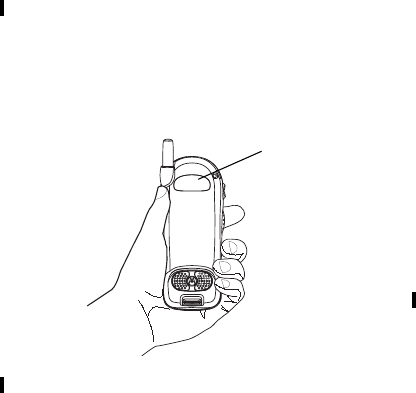
55
Updating Satellite Almanac Data
•Hold your phone to enhance reception. Signals
from GPS satellites are transmitted to your GPS
antenna, which is inside the back of your phone,
opposite the earpiece, behind the label with your
service provider’s name on it. Hold your phone
away from your body, giving the antenna clear
access to satellite signals. Do not cover the
antenna area with your fingers or anything else.
•Stand still. If possible, stand still until your phone is
finished determining your location. Moving your
phone at a walking pace while your phone is
calculating your approximate location may
substantially decrease GPS performance.
•Inacar.WhenusingtheGPSEnabledfeatureina
car, position your phone so that the GPS antenna
has good access to GPS signals through the car’s
windows. Typically, the GPS antenna has best
access to GPS signals in a car when placed near a
window.
Note: Although moving your phone at a walking
pace decreases GPS performance, moving
it at the speed of a moving car does not.
•Stay in network coverage. Depending on who your
service provider is, the network will provide your
phone with information that helps determine your
location more quickly and accurately.
Updating Satellite Almanac
Data
Another way to keep the GPS feature of your phone
working well is to keep your satellite almanac data up
to date.
The United States government maintains an almanac
of data about where GPS satellites are as they orbit
the Earth. This information is available to your phone.
Keeping your satellite almanac up to date helps your
phone determine your location more quickly.
GPS antenna area

56
GPS Enabled
The almanac contains information about the location
of satellites, their operational status, and other
satellite information. Keeping this information
updated enhances the performance of your GPS
feature. In most cases, your phone will be able to get
a fix in strong satellite signal conditions with outdated
almanac data, but it may take longer.
Note: Whenyoumakeanemergencycall,your
phone does not rely upon the almanac to
determine your location.
If your satellite almanac data is out of date, your
phone may prompt you to update it. Follow the
instructions that appear on the phone’s display. You
maybeaskedtogotoawebsiteorcallacustomer
care number.
Setting Privacy Options
Your phone’s GPS privacy options control whether
Java applications on your phone or other software
applications may view the location of your phone.You
may set your phone to one of these GPS privacy
options:
• Restricted — No Java or similar software
applications may view the location of your phone.
However, location information may still be
available to the phone’s owner, fleet manager, or
account administrator.
• Unrestricted — All applications may view the
location of your phone, without notifying you.
•ByPermission— When an application attempts
to view the location of your phone, you will be
prompted to give permission. However, location
information may still be available to the phone’s
owner, fleet manager, or account administrator.
Note: Privacy options do not apply to the
transmission of location information during
emergency 911 calls.
To set your GPS privacy options:
1From the main menu, select GPS > Privacy.
2If your GPS PIN security feature is enabled, enter
your GPS PIN. (See “Setting the GPS PIN Security
Feature” on page 56 for more information.)
3Scroll to the privacy setting you want.
4Press Aunder Select.
Setting the GPS PIN Security Feature
To prevent your GPS privacy settings from being
altered without your knowledge, your GPS privacy
option can be protected by a PIN.
When you receive your phone, the GPS security
feature is turned off, so you do not have to enter a
GPS PIN to access your GPS privacy options. If you
turn this feature on, you will be required to enter a
GPS PIN to access your GPS privacy options.

57
Using GPS with Map Software
To turn the GPS Enabled security feature on or off:
1From the main menu, select Settings > Security >
GPS PIN.
2Scroll to On or Off.
3Press Aunder Select.
4Enter the current GPS PIN.
Note: When you receive your phone, your GPS
PIN is 0000.
5Press Aunder Ok.
To change your GPS PIN:
1From the main menu, select Settings > Security >
Change Password > GPS PIN.
2Enter the current GPS PIN.
Note: When you receive your phone, your GPS
PIN is 0000.
3Press Aunder Ok.
4Enterthenew4-to8-digitGPSPIN.
5Press Aunder Ok.
6Enterthenew4-to8-digitGPSPINtoconfirm.
7Press Aunder Ok.
Using GPS with Map Software
You can use GPS feature of your phone to provide
approximate location data to a laptop computer or
similar device that is running interactive map software
such as that made by DeLorme or Microsoft. This
way, if your phone has good access to GPS signals,
your approximate position on a map can be made
available as you travel in a vehicle.
To do this, connect your phone to your laptop (or
other device) with a data cable and set your phone to
transmit data (see “Getting Started” on page 58).
Your phone then provides your approximate location
to the device running the map software, which
displays your location on a map. Your phone
provides an updated location every second and the
map software displays your changing location on its
map.
See “Enhancing GPS Performance” on page 54 for
more details on obtaining good location information.
Note: Because your phone is continuously
determining your location, using the GPS
feature of your phone with map software
uses the phone’s battery power quickly.
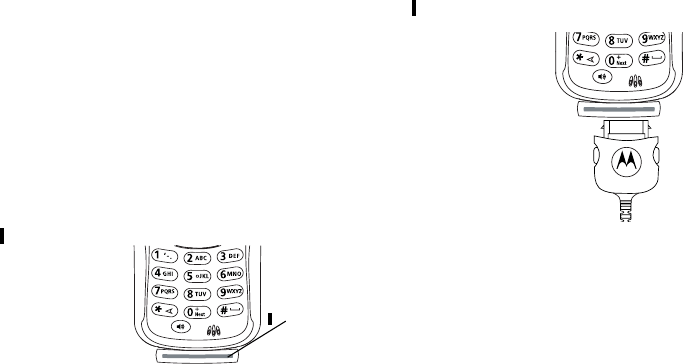
58
GPS Enabled
Software Compatibility
Your phone sends location information to your laptop
or other device using the standard National Marine
Electronics Association (NMEA) format. Your phone
supports output messages in NMEA-0183 format and
supports the following NMEA-0183 sentences: GGA,
GLL, GSA, GSV, RMC, and VTG.
The map software running on your laptop or other
device must support NMEA 3.0.
Getting Started
To connect your phone to your laptop or other device:
1Open the flap covering the phone’s accessory
connector.
2With the phone’s display facing up, insert the data
cable’s connector into accessory connector, until
you hear a click.
3InsertthedataplugintotheCOMportofyour
laptop or other device.
Ensure the COM port settings of your laptop or other
device are set to the following:
•Bits per second: 4800
•Data bits: 8
•Parity: None
•Stop bits: 1
•Flow control: Hardware
To set your phone to send location information to
your laptop or other device:
1From the main menu, select GPS > Interface.
flap
59
Using GPS with Map Software
2Press Aunder Change.
3Scroll to On.
4Press Aunder Select. Your phone is now sending
location data to your laptop or other device.
To stop your phone from sending location data to
your laptop or other device:
Set Interface to Off and press Aunder Select.
Each time you power your phone on, Interface is
automatically set to Off.
60
GPS Enabled

61
Voice Records
Note: This feature may not be offered by your
service provider.
A voice record is a recording you make with your
phoneandcanplayback.Youcanrecordanoteto
yourself or record the incoming portion of a phone
call.
Yourphonecanstoreupto20voicerecords,witha
total time of about 3 minutes, depending on available
memory.
Creating Voice Records
To record a note to yourself:
1From the main menu, select VoiceRecd > [New
VoiceRec].
2Press Aunder Record. Say the message you
want to record into the microphone.
3When you are finished recording, press Aunder
Stop.
Toaddtotheendofvoicerecord:
1From the main menu, select VoiceRecd.
2Scroll to the voice record you want to add to.
3Press m.
4Scroll to Add To.
5Press Aunder Select. Say the message you want
to add into the microphone.
6When you are finished recording, press Aunder
Stop.
To record the incoming portion of a phone call:
1While on an active call, press m.
2Scroll to Record.
3Press Aunder Select to start recording.
4When you are finished recording, press Aunder
Stop.
Note: Recording of phone calls is subject to
applicable laws regarding privacy and
recording of phone conversations.
Playing Voice Records
1From the main menu, select VoiceRecd.
2Scroll to the voice record you want to play.
3Press Aunder Play.
4To stop the voice record while it is playing, press A
under Back.

62
Voice Records
Labelling Voice Records
When you create a voice record, it is labeled with the
time and date it was recorded. You then can rename
it with a custom label.
1From the main menu, select VoiceRecd.
2Scroll to the voice record you want to label.
3Press m.
4Select Label.
5Enter the label you want to assign. See “Entering
Text”onpage75.
6Press Aunder Ok.
Deleting Voice Records
To delete a voice record:
1From the main menu, select VoiceRecd.
2Scroll to the voice record you want to delete.
3Press m.
4Select Delete.
5Press Aunder Yes to confirm.
To delete all voice records:
1From the main menu, select VoiceRecd.
2Press m.
3Select Delete All.
4Press Aunder Yes to confirm.
Locking Voice Records
When you lock a message, it cannot be deleted until
you unlock it.
1From the main menu, select VoiceRecd.
2Scroll to the message you want to lock or unlock.
3Press m.
4Scroll to Lock to lock the message. -or-
Scroll to Unlock to unlock the message.
5Press Aunder Select.
When a voice record is locked, this icon Rappears
next to it.
Managing Memory
To view the amount of memory available for voice
records:
1From the main menu, select VoiceRecd.
2Press m.
3Select Memory.
To free more memory by deleting all unlocked voice
records:
1From the main menu, select VoiceRecd.
64
Voice Records

65
Advanced Calling
Features
Call Waiting
Call Waiting lets you receive a second call while on a
call. Call Waiting is always available, unless you turn
it off for a specific call.
Ifyouareonacallandreceiveasecondcall,your
phone emits a tone and displays a messaging saying
you are receiving a second call.
To accept the second call and put the active call on
hold:
Press Aunder Yes.
To accept the second call and end the active call:
Press e.
To decline the second call:
Press Aunder No. If you subscribe to voice mail,
the call is forwarded to your voice mail box.
Switching Between Calls
When you accept a second call, the display shows
the name or number of each call, with an icon
indicating which call is active:
Tomakethecallonholdactiveandputtheactivecall
on hold:
Press Aunder Switch.
Turn Off Call Waiting
To turn off Call Waiting during a call:
1Press m.
2Select Call Waiting.
3Press Aunder Change.
4Scroll to Off.
Tip: To turn Call Waiting back on while still on the
call: Scroll to On.
5Press Aunder Select.
VPhone call is active.
ZPhone call is on hold.

66
Advanced Calling Features
To turn off Call Waiting for the next call you make or
receive:
1From the main menu, select Settings > Phone
Calls > Call Waiting.
2Press Aunder Change.
3Scroll to Off.
4Press Aunder Select.
CallWaitingisturnedbackonwhenyouendthecall.
Call Hold
Call Hold lets you put an active call on hold and make
a second call.
To put a call on hold:
1Whileonanactivecall,pressm.
2Scroll to Hold.
3Press Aunder Select.
4If you want to make the call active again, press A
under Resume.
To make a second call while a call is on hold:
1Enter the number you want to call.
Tip: To enter the number from Contacts: Press m.
Select Contacts.
2Press sto place the call.
To end the second call and make the call on hold
active again:
Press e.
Tomakethecallonholdactiveandputtheactivecall
on hold:
Press Aunder Switch.
3-Way Calling
3-way calling lets you combine 2 phone calls into
one. All 3 people in the call can speak to and hear
each other.
Tomakea3-waycall:
1Place or receive a phone call.
2While the call is active, press m.
3Scroll to 3-Way.
4Press Aunder Select. This puts the call on hold.
5Enter the second phone number you want to call.
Tip: To enter the number from Contacts: Press m.
Select Contacts.
6Press sto place the call.
7While the second call is active, press m.
8Scroll to 3-Way.
9Press Aunder Select.
Both calls are now active and appear on the display.

67
Creating Pauses and Waits While Dialing
Creating Pauses and Waits
While Dialing
You can enter a pause or wait while dialing a number.
For more information on pauses and waits, see
“Creating Pauses and Waits” on page 30.
To create a pause while dialing a phone number:
1From the keypad, enter the digits you want to
occur before the pause.
2Press m.
3Select Insert Pause.
4Enter the digits you want to occur before the
pause.
To create a pause while dialing a phone number:
1From the keypad, enter the digits you want to
occur before the pause.
2Press m.
3Select Insert Wait.
4Enter the digits you want to occur before the
pause.
Making International Calls
Plus Dialing lets you place an international call to
most countries without entering the local international
access code.
1Press and hold 0for two seconds. A “0” appears,
then changes to a “+”.
Note: The network translates the “+” into the
appropriate international access code
needed to place the call.
2Enter the country code, city code, or area code,
and phone number.
Setting One Touch PTT
One Touch PTT sets your phone to call the most
recent Private ID on the recent calls list, or to a
Private ID you choose, every time you press the PTT
button.
To set your phone to call the most recent Private ID
on the recent calls list:
1From the main menu, select Settings > 2-Way
Radio > One Touch PTT.
2Scroll to Last Call.
3Press Aunder Select.

68
Advanced Calling Features
To set your phone to call a Private ID you choose:
1From the main menu, select Settings > 2-Way
Radio > One Touch PTT.
2Scroll to Assign Number.
3Press Aunder Change.
4To enter the number you want your phone to call
every time your press the PTT button:
Enter the number using your keypad. -or-
Press Aunder Search. Select Contacts,Recent
Calls,orMemo. Enter the number from Contacts,
the recent calls list, or Memo, as you would when
makingacall.
Tip: If you are entering a Talkgroup number, enter
# before the number.
5Press Aunder Ok.
To turn off One Touch PTT:
1From the main menu, select Settings > 2-Way
Radio > One Touch PTT.
2Scroll to Off.
3Press Aunder Select.
Group Calls
A group call is a Private call made to all members a
Talkgroup at once. A Talkgroup is a group of Private
IDs. Your sales representative or your service
provider creates Talkgroups for you and assigns
each Talkgroup a Talkgroup number. You can
choose a name for each of your Talkgroups when
youcreateentriesfortheminContacts.
Making Group Calls
1Press #. Then enter the Talkgroup number using
the keypad. -or-
Choose the Talkgroup name from Contacts or
recent calls list.
2ProceedasifmakingaPrivatecall.
Receiving Group Calls
To receive group calls made to a Talkgroup, you
must join the Talkgroup. You can belong to only one
Talkgroup at a time. When you join a new Talkgroup,
younolongbelongtoyourpreviousTalkgroup.
To join a Talkgroup:
1Press #. Then enter the Talkgroup number using
the keypad. -or-
Choose the Talkgroup name from Contacts or
recent calls list.

69
Call Timers
2Press Aunder Join.
To answer a group call:
Proceed as if answering a Private call. Only one
person at a time may speak on a group call.
TurningoffGroupCalls
To control whether you hear group calls or call alerts
to your Talkgroup:
1From the main menu, select Settings > 2-Way
Radio > Talkgroup Silent.
2Press Aunder Change.
3Scroll to On if you don’t want to hear group calls or
call alerts to your Talkgroup. -or-
Scroll to Off ifyouwanttoheargroupcallsorcall
alerts to your Talkgroup.
4Press Aunder Select.
Call Timers
Call timers measure the duration of your phone calls,
Private or group calls, and circuit data use, as well as
the number of Kilobytes sent and received by your
phone:
•LastCall— displays the duration of your most
recent phone call.
• Phone Reset — keeps a running total of your
phone call minutes, until you reset it.
• Phone Lifetime — displays the total minutes of all
your phone calls.
• Prvt/Grp Reset — keeps a running total of all of
your Private and group call minutes, until you reset
it.
• Prvt/Grp Lifetime — displays the total minutes of
all your Private and group calls.
• Circuit Reset — keeps a running total of all of
your circuit data use, until you reset it.
• Circuit Lifetime — displays the total minutes of all
of your circuit data use.
• Kbytes Reset — keeps a running total of the
number of Kilobytes sent and received by your
phone, until you reset it.
To view or reset a timer:
1From the main menu, select Call Timers.
2Selectthefeatureyouwanttovieworreset.
3To view a feature without resetting: Press Aunder
Done when you are finished viewing. -or-
To reset a feature: Press Aunder Reset.PressA
under Yes to confirm.
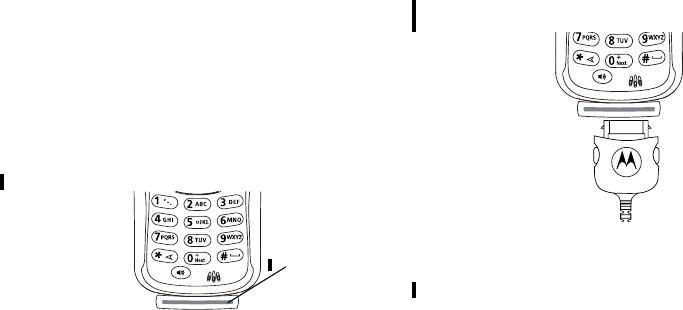
70
Advanced Calling Features
Note: The values displayed by Call Timers should
not be used for billing. Call timers are
estimates only.
Using Your Phone as a Modem
Note: This feature may not be offered by your
service provider.
To use your phone as a modem with a laptop,
handheld device, or desktop computer:
1Open the flap covering the phone’s accessory
connector.
2With the phone’s display facing up, insert a data
cable’s connector into accessory connector, until
you hear a click.
3Insert the data plug into the COM port of the other
device.
When used as a modem, your phone has these data
transfer modes:
•Circuit data — used for sending and receiving
faxes and for transferring large files
•Packet data — used for small file transfers such as
email
flap

71
Making TTY Calls
To use these services, you must install the iDEN
Wireless Data Services software (available
separately). For more information on setting up your
computer and your i205 phone for packet and circuit
data calls, see the Wireless Data Services User’s
Guide or contact your service provider.
Making TTY Calls
Note: This feature may not be offered by your
service provider.
To use your phone to make phone calls using a
teletypewriter (TTY) device:
1Connect one end of a 2.5mm cable into the audio
jack on your phone. Connect the other end of the
cabletoyourTTYdevice.
2Make sure that your phone’s TTY feature is on and
select the TTY mode you want to use.
3Use your phone to enter phone numbers and make
calls.
TTY device manufacturer’s proprietary feature such
as Turbo-Code, High-Speed, and Interruption are not
supported by your phone. These features must be
turned off or disabled to use your TTY device with
your phone.
TurningOntheTTYFeature
Your phone’s TTY feature must be on if you want to
make TTY calls, set the TTY mode, or change the
TTY baud rate. To make sure the TTY feature is on:
From the main menu, select Settings > Phone
Calls > TTY. This field must say On.
Choosing a Mode
Your phone supports these TTY modes:
• TTY — You type and read text on your TTY device.
•VCO(Voice-Carry-Over) — You speak into your
phone and read text replies on your TTY device.
• HCO (Hearing-Carry-Over) — You type text on
your TTY device and listen to voice replies on your
phone speaker.
To change mode while not in a call:
1From the main menu, select Settings > Phone
Calls > TTY > Type.
2Press Aunder Change.
3ScrolltotheTTYmodeyouwant.
4Press Aunder Select.
When you make a TTY call, the call begins in the TTY
mode you last selected.

72
Advanced Calling Features
To change mode during a call using your phone:
1Press m.
2Select TTY > Type.
3Selectthemodeyouwant.
To change mode during a call using your TTY device,
issue one of the following command:
•“VCO please” — to select VCO mode
•“HCO please” — to select HCO mode
•“HCO off please” — to turn off HCO mode
Important: When you are using HCO, the sound
coming from your phone speaker may be
uncomfortably loud. Use caution when
putting the phone to your ear. (For
information on setting the volume of your
phone speaker, see “Setting the Volume”
on page 79.)
Changing the TTY Baud Rate
By default, your phone’s TTY baud rate is set to
45.45, the baud rate required for TTY calls within the
U.S. To make calls outside the U.S., set your TTY
baud rate to 50.0.
To change the TTY baud rate:
1From the main menu, select Settings > Phone
Calls>TTY>Baud.
2Press Aunder Change
3Scroll to the baud rate for your location.
4Press Aunder Select.

73
Memo
Memoletsyoustoreanumber,makeacalltothat
number, and save it to Contacts.
To create a memo:
1From the main menu, select Memo.
2Enter the number using your keypad.
3Press Aunder Store.
To view the memo later:
1From the main menu, select Memo.
To delete the memo:
1From the main menu, select Memo.
2Press and hold Aunder Delete.
3Press Aunder Store.
To edit the memo:
1From the main menu, select Memo.
2Enter the new number.
3Press Aunder Store.
To make a call to the memo number:
1From the main menu, select Memo.
2Press s.
To store the memo number to Contacts:
1From the main menu, select Memo.
2Press m.
3Press Aunder Select.
4To store the number as a new entry, press Aunder
Select.-or-
To store the number in an existing entry: Scroll to
the entry. Press Aunder Select.
5Scroll left or right to the Contacts type you want to
assign the number.
6Press Aunder Change.
7If you want to add more information to the entry,
follow the applicable instructions in “Creating
Entries” on page 27.
8Press Aunder Done.
74
Memo

75
Entering Text
You can enter text into your phone using the
traditional method of pressing a key several times for
each character, or by pressing a key once for each
letter while likely words are chosen from a database.
You can also enter symbols and numbers into a text
field.
At any screen that requires you to enter text, you see
the following icons near the top right corner. These
icons tell you which text input mode you are using:
When you access a screen that requires you to enter
text, you start in Alpha mode.
To choose a text input mode:
1At a screen that requires you to enter text, press
m.
2A checkmark appears next to the current text input
mode. Scroll to the text input mode you want to
use.
3Press Aunder Select.
Using Alpha Mode
•Press any key on the keypad to enter the letters,
numbers, and symbols on that key. For example,
to enter the letter Y, press 9three times.
•Typealetterthenscrolluptomakethatletter
uppercase, or type a letter then scroll down to
make that letter lowercase.
•Press #for a space.
•Press Aunder Delete to delete a character. Press
and hold Aunder Delete to delete an entire entry.
UsingWordMode
In Word mode, T9 Text Input analyzes the letters on
the keypad button you press and arranges them to
create words. As you type, T9 Text Input matches
your keystrokes to words in its database and displays
the most commonly used matching word. You can
add you own words to this database.
Entering a Word
1Select Word as your text input mode.
iAlpha — Press a key several times for each
character.
jWord — Press a key once for each letter while
likely words are chosen from a database.
kSymbols — Enter punctuation and other
symbols.
lNumeric — Enter numbers.

76
Entering Text
2Type a word by pressing one key for each letter.
For example, to type “test” press 8378.
The displayed word may change as you type it. Do
not try to correct the word as you go. Type to the
end of the word before editing.
3If the word that appears is not the desired word,
press 0to change the word on the display to the
next most likely word in the database.
Repeat until the desired word appears.
If the desired word does not appear, you can add it to
the database of words using the instructions in
“Adding Words to the User Database” on page 76.
Special Key Functions
Some of the phone’s keys assume different functions
whileinWordmode.
Shift and Caps Lock
Press #to make the next letter typed uppercase
(shift), to make all subsequent letters types
uppercase (caps lock), or to go back to lowercase
letters.
These icons appear in the top row of your display:
When neither of these icons appear, letters typed are
lowercase.
Note: T9 Text Input automatically makes the first
letter of a sentence uppercase.
Punctuation
In Word mode, T9 Text Input uses Smart Punctuation
to insert the correct punctuation within a word and at
the end of a sentence.
Press 1to insert punctuation. One of eight basic
punctuation symbols will be inserted (. , - ’ @ : ? ;).
Press 0to change the inserted punctuation symbol
to another of the eight basic punctuation symbols.
Note: Additional punctuation symbols are available
in Symbols mode.
Adding Words to the User Database
1Select Alpha as your text input mode.
2Type the word using Alpha mode.
3Select Word as your text input mode.
4Press #.
mShift is on.
nCaps lock is on.

77
Using Numeric Mode
ThewordyoutypedinAlphatextentrymodeisnow
in the database.
NOTE:You cannot store alphanumeric
combinations, such as Y2K.
Choosing a Language
To change the language of the database T9 Text
Input chooses words from:
1At a screen that requires you to enter text, press
m.
2Select Languages.
3Scroll to the language you want for your database.
4Press Aunder Select.
Using Numeric Mode
1Select Numeric as your text input mode.
2Press the number buttons on your keypad to enter
numbers.
Using Symbols Mode
1Select Symbols as your text input mode.
A row of 32 symbols appears along the bottom of
the phone’s display. Scroll right to view the
complete row.
2Scroll left or right to choose the symbol you want to
enter.
3Press Aunder Select.
78
Entering Text

79
Customizing Your Phone
Setting the Volume
To set the volume of the sound coming from the
phone’s earpiece or speaker:
1From the main menu, select Settings > Volume.
2Scroll to Earpiece to set the earpiece volume. -or-
Scroll to Speaker to set the speaker volume.
3Press Aunder Change.
4To select the volume:
Scroll left or right. -or-
Press the volume keys on the side of your phone.
5Press Aunder Ok.
To set the volume of the phone’s ring:
Press the volume keys on the side of your phone.
For another way to set the volume of the phone’s
ring, or the volume of many other sounds your phone
makes:
1From the main menu, select Settings > Volume.
2Scroll to the option you want and make the
change. Choose Line 1 or Line 2 to set the volume
of the phone’s ring when you get a call on that line.
See “Volume Features” on page 82.
Setting Your Phone to Not Ring
To set your phone to make no sound when you
receive phone calls, Private calls, group calls,
message notifications, and call alerts, see “Turning
Ring Tones Off” on page 37.
To set your phone to vibrate instead of making a
sound when you receive Private calls and group
calls, even if you want your phone to ring for other
features:
1From the main menu, select Settings > 2-Way
Radio > Alert Type.
Tip: If Alert Type does not appear: From the main
menu, select Ring Tones. Make sure Vibrate
All or SilentAll is set to Off. Repeat step 1.
2Press Aunder Change.
3Scroll to Vibe.
4Press Aunder Select.
Note: This feature may not be offered by your
service provider.
If your phone does not include a vibrate feature, you
can still set your phone make no sound. Scroll to
Silent in step 3.

80
Customizing Your Phone
Seeing the Display Better
To set the contrast of the display:
1From the main menu, select Settings >
Display/Info > Contrast.
2Press Aunder Change.
3Scroll left or right to set the contrast.
4Press Aunder Ok.
Using a Headset
If you use a headset or similar device with your
phone, you can set your phone to send incoming
sound to the headset only, or to the headset and the
speaker at the same time:
1From the main menu, select Settings > Advanced
> Headset/Spker.
2Press Aunder Change.
3Scroll to HdsetOnly to send incoming sound to the
headset only. -or-
Scroll to Hdset&Spker to send incoming sound to
the headset and the speaker at the same time.
4Press Aunder Select.
Changing the Faceplate
To give your phone a new look by changing its
faceplate:
1Remove the battery cover as described in
“Removing the Battery” on page 4.
2Carefully pull the faceplate away from the rest of
your phone.
3Place the new faceplate on to your phone and
press it gently until you hear a click.
To order new faceplates for your phone, log on to our
Web site at www.motorola.com/store/iden or contact
your Motorola Authorized Retailer.
Using Settings
Settings contains many submenus that let you
customize your phone.

81
Using Settings
Display/Info Features
The Display/Info menu controls how the keypad and
display appear:
• Backlight — controls how long backlight stays on
after you make or receive a call.
•Clock— controls whether the time and date
appears on the idle screen, sets the format of the
time and date, and sets the year.
•Contrast— sets the contrast on the display. See
“Seeing the Display Better” on page 80.
•Language— sets the language that your phone
displays.
Phone Calls Features
The Phone Calls menu controls how your phone
handles phone calls:
•SetLine— sets phone line 1 or phone line 2 as
the active line for outgoing calls.
•AnyKeyAns— If this feature is on, you can
answer calls by pressing any key on the keypad.
•AutoRedial— sets your phone to automatically
redial calls you make when the system is busy.
•CallWaiting— See “Turn Off Call Waiting” on
page 65.
• Auto Ans — sets your phone to automatically
answer an incoming call after a specified number
of rings. When this feature is on, the phone
answers by connecting you to the caller; it does
not send the call to voice mail, unless you are out
of coverage or on the line.
• Minute Beep — causes beep to sound every
minute of an active call.
•CallDuration— causes the duration of a call to
appear on the phones display when the call ends.
• TTY — lets you use your phone with a TTY device.
See“MakingTTYCalls”onpage71.
• Notifications — See “Setting Notification Options”
on page 41.
2-Way Radio Features
The 2-Way Radio menu controls how your phone
handles Private calls and group calls:
• Tkgroup Silent — controls whether you hear
group calls or call alerts to your Talkgroup. See
“ReceivingGroupCalls”onpage68.
• Tkgroup Area — lets you name Talkgroups and
choose your Talkgroup area.
• One Touch PTT — See “Setting One Touch PTT”
on page 67.

82
Customizing Your Phone
•AlertType— sets your phone to make no sound
when you receive Private calls and group calls.
See page 79.
Volume Features
The Volume menu sets the volume of sounds your
phone makes:
•Line1— sets ringer volume for phone line 1.
•Line2— sets ringer volume for phone line 2.
• Messages — sets the volume of message
notifications.
•Earpiece— sets the volume of sound coming out
of the earpiece.
• Speaker — sets the volume of sound coming out
of the speaker.
•Keypad— sets the volume of sound associated
with pressing keys and buttons.
•Data— sets the volume of sounds that notifies you
that you are receiving a circuit data call.
Security Features
The Security menu lets turn security features on and
off and change passwords:
• Phone Lock — turns on a feature that locks your
phone, either immediately or automatically after a
set period of inactivity. An unlock code is required
to enable this feature, to unlock the phone, and to
set a new Unlock code. Contact your service
provider for your default unlock code.
•KeypadLock— locks the phone’s keypad, either
immediately or automatically after a set period of
inactivity. See “Locking the Keypad” on page 9 for
more information on locking and unlocking the
keypad.
•SIMPIN— enables and disables your phone’s
SIM PIN security feature. See “Turning the PIN
Requirement On and Off” on page 11.
• GPS PIN — enables and disables your phone’s
GPS PIN security feature. See “Setting the GPS
PIN Security Feature” on page 56.
• Change Passwords — changes your phone
unlock code, security code SIM PIN, and GPS PIN.
Advanced Features
The Advanced menu contains advanced and rarely
used Settings features.
• Alert Timeout — controls the amount of time a
tone continues to sound when you receive a
message notification or call alert.

83
Using Settings
• Headset/Spker — See “Using a Headset” on page
80.
• Connectivity —Network ID sets the phone’s
network IDs and their roaming options under the
direction of your service provider; Master Reset
lets your service provider to reset your service in
the event of a security or provisioning problem.
• Reset Defaults —Reset Settings returns all
settings to their original defaults; Reset All returns
all settings to their original defaults and erases all
stored lists. Use only under the direction of your
service provider.
• ReturntoHome— controls how long the recent
calls list displays after calls.
• Phone Only — prevents your phone from making
or receiving Private calls or group calls.
•BaudRate— sets the baud rate at which your
phone communicates with a laptop computer, PC,
or similar device.
84
Customizing Your Phone
85
Safety and General
Information
IMPORTANT INFORMATION ON SAFE AND
EFFICIENT OPERATION.
READ THIS INFORMATION BEFORE USING YOUR
INTEGRATED MULTI-SERVICE PORTABLE
RADIO.
RF Operational Characteristics
Your radio product contains a radio frequency
transmitter to convey the information you wish to
send as well as occasional automatic signals used to
sustain connection to the wireless network, and a
receiver which enables you to receive communication
and connection information from the network.
Portable Radio Product
Operation and EME Exposure
Your Motorola radio product is designed to comply
with the following national and international
standards and guidelines regarding exposure of
human beings to radio frequency electromagnetic
energy (EME):
•United States Federal Communications
Commission, Code of Federal Regulations; 47
CFR part 2 sub-part J.
•American National Standards Institute (ANSI) /
Institute of Electrical and Electronics Engineers
(IEEE). C95. 1-1992.
•Institute of Electrical and Electronics Engineers
(IEEE). C95. 1-1999 Edition.
•International Commission on Non-Ionizing
Radiation Protection (ICNIRP) 1998.
•Ministry of Health (Canada). Safety Code 6. Limits
of Human Exposure to Radiofrequency
Electromagnetic Fields in the Frequency Range
from 3 kHz to 300 GHz, 1999.
•Australian Communications Authority
Radiocommunications (Electromagnetic Radiation
- Human Exposure) Standard 2001.
•ANATEL, Brasil Regulatory Authority, Resolution
256 (April 11, 2001) “additional requirements for
SMR, cellular and PCS product certification.”
To assure optimal radio product performance and
make sure human exposure to radio frequency
electromagnetic energy is within the guidelines
set forth in the above standards, always adhere
to the following procedures:

86
Safety and General Information
Phone Operation
When placing or receiving a phone call, hold your
radio product as you would a wireline telephone.
Speak directly into the microphone.
Two-way radio operation
When using your radio product as a
traditional two-way radio, hold the
radio product in a vertical position
with the microphone one to two
inches (2.5 to 5 cm) away from the lips.
Body-worn operation
To maintain compliance with FCC RF exposure
guidelines, if you wear a radio product on your body
when transmitting, always place the radio product in
a Motorola approved clip, holder, holster, case or
body harness for this product.Useof
non-Motorola-approved accessories may exceed
FCC RF exposure guidelines. Ifyoudonotusea
Motorola approved body-worn accessory and are
not using the radio product in the intended use
positions along side the head in the phone mode
or in front of the face in the two-way radio mode,
then ensure the antenna and the radio product
are kept the following minimum distances from
the body when transmitting
• Phone or Two-way radio mode: one inch (2.5
cm)
• Data operation using any data feature with or
without an accessory cable: one inch (2.5 cm)
Antenna Care
Use only the supplied or an approved
replacement antenna. Unauthorized antennas,
modifications, or attachments could damage the
radio product and may violate FCC regulations.
DO NOT hold the antenna when the radio product
is “IN USE”. Holding the antenna affects call quality
and may cause the radio product to operate at a
higher power level than needed.
Approved Accessories
For a list of approved Motorola accessories call
1-800-453-0920, or visit our website at
www.mot.com/iden.
87
Portable Radio Product Operation and EME Exposure
ALL MODELS WITH FCC ID AZ489FT5822 MEET THE
GOVERNMENT’S REQUIREMENTS FOR EXPOSURE TO
RADIO WAVES.
Your wireless phone is a radio transmitter and receiver. It is
designed and manufactured not to exceed the emission limits
for exposure to radiofrequency (RF) energy set by the
Federal Communications Commission of the U.S.
Government. These limits are part of comprehensive
guidelines and establish permitted levels of RF energy for the
general population. The guidelines are based on standards
that were developed by independent scientific organizations
through periodic and thorough evaluation of scientific studies.
The standards include a substantial safety margin designed
to assure the safety of all persons, regardless of age and
health.
The exposure standard for wireless mobile phones employs
a unit of measurement known as the Specific Absorption
Rate,orSAR.TheSARlimitsetbytheFCCis1.6W/kg.
*
Tests for SAR are conducted using standard operating
positions reviewed by the FCC with the phone transmitting at
its highest certified power level in all tested frequency bands.
Although the SAR is determined at the highest certified
power level, the actual SAR level of the phone while
operating can be well below the maximum value. This is
because the phone is designed to operate at multiple power
levels so as to use only the power required to reach the
network. In general, the closer you are to a wireless base
station antenna, the lower the power output.
Before a phone model is available for sale to the public, it
must be tested and certified to the FCC that is does not
exceed the limit established by the government-adopted
requirement for safe exposure. The tests are performed in
positions and locations (e.g., at the ear and worn on the
body) as required by the FCC for each model. The highest
SAR value for this model phone when tested for use at the
ear is 1.19 W/kg and when tested on the body, as described
in this user guide, is 1.39 W/kg during packet data
transmission. (Body-worn measurements differ among phone
models, depending upon available accessories and FCC
requirements.) While there may be differences between the
SAR levels of various phones and at various positions, they
all meet the government requirement for safe exposure.
The FCC has granted an Equipment Authorization for this
model phone with all reported SAR levels evaluated as in
compliance with the FCC RF exposure guidelines. SAR
information on this model phone is on file with the FCC and
can be found under the Display Grant section of
http://www.fcc.gov/oet/fccid after searching on FCC ID
AZ489FT5822.
Additional information on Specific Absorption Rates (SAR)
can be found on the Cellular Telecommunications Industry
Association (CTIA) web-site at http://www.wow-com.com.
* In the United States and Canada, the SAR limit for mobile
phones used by the public is 1.6 watts/kg (W/kg) averaged
over one gram of tissue. The standard incorporates a
substantial margin of safety to give additional protection for
the public and to account for any variations in
measurements.
88
Safety and General Information
Electro Magnetic
Interference/Compatibility
Note: Nearly every electronic device is
susceptible to electromagnetic
interference (EMI) if inadequately
shielded, designed or otherwise
configured for electromagnetic
compatibility.
Facilities
To avoid electromagnetic interference and/or
compatibility conflicts, turn off your radio product in
any facility where posted notices instruct you to do
so. Hospitals or health care facilities may be using
equipment that is sensitive to external RF energy.
Aircraft
When instructed to do so, turn off your radio product
when on board an aircraft. Any use of a radio product
must be in accordance with applicable regulations
per airline crew instructions.
Medical Devices
Pacemakers
The Advanced Medical Technology Association
(AdvaMed) recommends that a minimum separation
of 6 inches (15 cm) be maintained between a
handheld wireless radio product and a pacemaker.
These recommendations are consistent with those of
the U.S. Food and Drug Administration.
Persons with pacemakers should:
•ALWAYS keep the radio product more than 6
inches (15 cm) from their pacemaker when the
radio product is turned ON.
•Not carry the radio product in a breast pocket.
•Use the ear opposite the pacemaker to minimize
the potential for interference.
•Turn the radio product OFF immediately if you
have any reason to suspect that interference is
taking place.
Hearing Aids
Some digital wireless radio products may interfere
with some hearing aids. In the event of such
interference, you may want to consult your hearing
aid manufacturer to discuss alternatives.

89
Operational Warnings
Other Medical Devices
If you use any other personal medical device, consult
the manufacturer of your device to determine if it is
adequately shielded from RF energy. Your physician
may be able to assist you in obtaining this
information.
Use While Driving
Check the laws and regulations on the use of radio
products in the area where you drive. Always obey
them.
When using the radio product while driving, please:
•Give full attention to driving and to the road.
•Use hands-free operation, if available.
•Pull off the road and park before making or
answering a call if driving conditions so require.
Operational Warnings
For Vehicles with an Air Bag
Do not place a portable radio product in the area over
the air bag or in the air bag deployment area. Air
bags inflate with great force. If a portable radio is
placed in the air bag deployment area and the air bag
inflates, the radio product may be propelled with
great force and cause serious injury to occupants of
the vehicle.
Potentially Explosive Atmospheres
Turn off your radio product prior to entering any area
with a potentially explosive atmosphere, unless it is a
radio product type especially qualified for use in such
areas as “Intrinsically Safe” (for example, Factory
Mutual, CSA, or UL approved). Do not remove,
install, or charge batteries in such areas. Sparks in a
potentially explosive atmosphere can cause an
explosion or fire resulting in bodily injury or even
death.
Note: The areas with potentially explosive
atmospheres referred to above include
fueling areas such as below decks on
boats, fuel or chemical transfer or
storage facilities, areas where the air
contains chemicals or particles, such as
grain, dust or metal powders, and any
!!

90
Safety and General Information
other area where you would normally be
advised to turn off your vehicle engine.
Areas with potentially explosive
atmospheres are often but not always
posted.
Blasting Caps and Areas
To avoid possible interference with blasting
operations, turn off your radio product when you are
near electrical blasting caps, in a blasting area, or in
areas posted: “Turn off two-way radio”. Obey all signs
and instructions.
Operational Cautions
Antennas
Do not use any portable radio product that has a
damaged antenna. If a damaged antenna comes
into contact with your skin, a minor burn can result.
Batteries
All batteries can cause property damage and/or
bodily injury, such as burns if a conductive material
such as jewelry, keys, or beaded chains touches
exposed terminals. The conductive material may
complete an electrical circuit (short circuit) and
become quite hot. Exercise care in handling any
charged battery, particularly when placing it inside a
pocket, purse, or other container with metal objects.
Cleaning and Drying Considerations
Using a leather carry case may help protect the
surfaces and help prevent liquids (e.g., rain) from
entering into the interior of the radio product. This
product is not water proof, and exposing the unit to
liquids may result in permanent damage to the unit.
If your radio product interior gets wet, then do not try
to accelerate drying with the use of an oven or a dryer
as this will damage the radio product and void the
warranty. Instead, do the following:
1Immediately power off the radio product.
2Remove Battery and SIM card (if so equipped)
from radio product.
3Shake excess liquid from radio product.
4Place the radio product and battery in an area that
is at room temperature and has good air flow.
5Let the radio product, battery, and SIM card dry for
72 hours before reconnecting the battery and/or
powering on the radio product.
If the radio product does not work after following the
steps listed above, contact your dealer for servicing
information.
!

91
Accessory Safety Information
Clean the external surfaces of the radio product with
adampcloth,usingamildsolutionofdishwashing
detergent and water. Some household cleaners may
contain chemicals that could seriously damage the
radio product. Avoid the use of any petroleum-based
solvent cleaners. Also, avoid applying liquids directly
on the radio product.
Accessory Safety Information
Important: Save these accessory safety instructions.
•Before using any battery or battery charger, read
all the instructions for and cautionary markings on
(1) the battery, (2) the battery charger, which may
include a separate wall-mounted power supply or
transformer, and (3) the radio product using the
battery.
•Do not expose any battery charger to water, rain,
or snow as they are designed for indoor or
in-vehicle use only.
•To reduce the risk of damage to the cord or plug,
pull by the plug rather than the cord when you
disconnect the battery charger from the power
source outlet.
•Do not operate any battery charger with a
damaged cord or plug — replace them
immediately.
•Battery chargers may become warm during
operation, but not hot. If it becomes hot to the
touch, unplug it from the power outlet immediately
and discontinue its use.
•Use of a non-recommended attachment to a
battery charger may result in a risk of fire, electric
shock, or injury to persons.
•Make sure the battery charger power cord is
located so that it will not be stepped on, tripped
over, or subjected to damage or stress.
•An extension cord should not be used with any
battery charger unless absolutely necessary. Use
of an improper extension cord could result in a risk
of fire and electric shock. If an extension cord must
be used, make sure that:
•The pins on the plug of the extension cord are
the same number, size, and shape as those on
theplugofthecharger.
•The extension cord is properly wired and in
good electrical condition.
Warning: To reduce the risk of injury,
charge only the rechargeable batteries
listed in the “Battery” on page 2. Other
types of batteries may burst, causing
personal injury and damage.
!!
92
Safety and General Information
•The cord size is 18AWG for lengths up to 100
feet and 16AWG for lengths up to 150 feet.
•Do not operate any battery charger if it has
received a sharp blow, has been dropped, or
has been damaged in any way; take it to a
qualified service technician.
•Do not disassemble a battery charger; take it to
aqualifiedservicetechnicianwhenserviceor
repair is required. Incorrect reassembly may
result in a risk of electric shock or fire.
•Maximum ambient temperature around the
power supply or transformer of any battery
charger should not exceed 40°C (104°F).
•The output power from the power supply or
transformer must not exceed the rating given on
the Desktop Dual-Pocket Charger.
•The disconnection from the line voltage is made
by unplugging the power supply from the AC
receptacle.
•To reduce risk of electric shock, unplug any
battery charger from the outlet before attempting
any maintenance or cleaning.
For optimum charging performance, turn off the radio
product while charging it in any battery charger.
93
Driving Safety Tips
“Safety is your most important call!”
Your Motorola wireless telephone gives you the
powerful ability to communicate by voice — almost
anywhere, anytime, wherever wireless phone service
is available and safe conditions allow. But an
important responsibility accompanies that benefits of
wireless phones, one that every user must uphold.
When driving a car, driving is your first responsibility.
If you find it necessary to use your wireless phone
while behind the wheel of a car, practice good
common sense and remember the following tips:
•Get to know your Motorola wireless phone and its
features such as speed dial and redial. If available,
these features help you to place your call without
taking your attention off the road.
•When available, use a hands-free device. If
possible, add an additional layer of convenience to
your wireless phone with one of the many Motorola
Original hands-free accessories available today.
•Position your wireless phone within easy reach. Be
able to access your wireless phone without
removing your eyes from the road. If you receive
an incoming call at an inconvenient time, if
possible, let your voice mail answer it for you.
•Let the person you are speaking with know you are
driving; if necessary, suspend the call in heavy
traffic or hazardous weather conditions. Rain,
sleet, snow, ice, and even heavy traffic can be
hazardous.
•If you receive an incoming call at an inconvenient
time do not take notes or look up phone numbers
while driving. Jotting down a “to do” list or going
through your address book takes attention away
from your primary responsibility — driving safely.
•Dial sensibly and assess the traffic; if possible,
place calls when you are not moving or before
pullingintotraffic.Trytoplancallswhenyourcar
will be stationary. If you need to make a call while
moving, dial only a few numbers, check the road
and your mirrors, then continue.
•Do not engage in stressful or emotional
conversations that may be distracting. Make
people you are talking with aware you are driving
and suspend conversations which have the
potential to divert your attention away from the
road.
•Your phone can perform many other functions
besides allowing you to make and receive calls. Do
not let these features distract you from driving. Use
them only when it is safe to do so.
94
Driving Safety Tips
•Use your wireless phone to call for help. Dial 9-1-1
or other local emergency number in the case of
fire, traffic accident or medical emergencies.
•Use your wireless phone to help others in
emergencies. If you see an auto accident, crime in
progress or other serious emergency where lives
are in danger, call 9-1-1 or other local emergency
number, as you would want others to do for you.
•Call roadside assistance or a special
non-emergency wireless assistance number when
necessary. If you see a broken-down vehicle
posing no serious hazard, a broken traffic signal, a
minor traffic accident where no one appears
injured, or a vehicle you know to be stolen, call
roadside assistance or other special
non-emergency wireless number.

95
The U.S. Food
and Drug
Administration's
Center for Devices and
Radiological Health
Consumer Update on
Mobile Phones
FDA has been receiving inquiries about the safety of
mobile phones, including cellular phones and PCS
phones. The following summarizes what is known —
and what remains unknown — about whether these
products can pose a hazard to health, and what can
be done to minimize any potential risk. This
information may be used to respond to questions.
Why the concern?
Mobile phones emit low levels of radiofrequency
energy (i.e., radiofrequency radiation) in the
microwave range while being used. They also emit
very low levels of radiofrequency energy (RF),
considered non-significant, when in the stand-by
mode. It is well known that high levels of RF can
produce biological damage through heating effects
(thisishowyourmicrowaveovenisabletocook
food). However, it is not known whether, to what
extent, or through what mechanism, lower levels of
RF might cause adverse health effects as well.
Although some research has been done to address
these questions, no clear picture of the biological
effects of this type of radiation has emerged to date.
Thus, the available science does not allow us to
conclude that mobile phones are absolutely safe, or
that they are unsafe. However, the available scientific
evidence does not demonstrate any adverse health
effects associated with the use of mobile phones.
What kinds of phones are in question?
Questions have been raised about hand-held mobile
phones, the kind that have a built-in antenna that is
positioned close to the user's head during normal
telephone conversation. These types of mobile
phones are of concern because of the short distance
between the phone's antenna — the primary source
of the RF — and the person's head. The exposure to
RF from mobile phones in which the antenna is
located at greater distances from the user (on the
outside of a car, for example) is drastically lower than
that from hand-held phones, because a person's RF
exposure decreases rapidly with distance from the
source. The safety of so-called "cordless phones,"
96
The U.S. Food and Drug Administration's Center for Devices and Radiological Health Consumer Update
which have a base unit connected to the telephone
wiring in a house and which operate at far lower
power levels and frequencies, has not been
questioned.
How much evidence is there that
hand-held mobile phones might be
harmful?
Briefly, there is not enough evidence to know for
sure, either way; however, research efforts are
on-going. The existing scientific evidence is
conflicting and many of the studies that have been
done to date have suffered from flaws in their
research methods. Animal experiments investigating
the effects of RF exposures characteristic of mobile
phones have yielded conflicting results. A few animal
studies, however, have suggested that low levels of
RF could accelerate the development of cancer in
laboratory animals. In one study, mice genetically
altered to be predisposed to developing one type of
cancer developed more than twice as many such
cancers when they were exposed to RF energy
compared to controls. There is much uncertainty
among scientists about whether results obtained from
animal studies apply to the use of mobile phones.
First, it is uncertain how to apply the results obtained
in rats and mice to humans. Second, many of the
studies that showed increased tumor development
used animals that had already been treated with
cancer-causing chemicals, and other studies
exposed the animals to the RF virtually continuously
— up to 22 hours per day.
For the past five years in the United States, the
mobile phone industry has supported research into
the safety of mobile phones. This research has
resulted in two findings in particular that merit
additional study:
1In a hospital-based, case-control study,
researchers looked for an association between
mobilephoneuseandeitherglioma(atypeof
brain cancer) or acoustic neuroma (a benign tumor
of the nerve sheath). No statistically significant
association was found between mobile phone use
and acoustic neuroma. There was also no
association between mobile phone use and
gliomas when all types of types of gliomas were
considered together. It should be noted that the
average length of mobile phone exposure in this
study was less than three years.
2When 20 types of glioma were considered
separately, however, an association was found
between mobile phone use and one rare type of
glioma, neuroepithelliomatous tumors. It is
possible with multiple comparisons of the same
sample that this association occurred by chance.
Moreover, the risk did not increase with how often
the mobile phone was used, or the length of the
97
calls. In fact, the risk actually decreased with
cumulative hours of mobile phone use. Most
cancer causing agents increase risk with increased
exposure. An ongoing study of brain cancers by
the National Cancer Institute is expected to bear
on the accuracy and repeatability of these
results.(1)
3Researchers conducted a large battery of
laboratory tests to assess the effects of exposure
to mobile phone RF on genetic material. These
included tests for several kinds of abnormalities,
including mutations, chromosomal aberrations,
DNA strand breaks, and structural changes in the
genetic material of blood cells called lymphocytes.
None of the tests showed any effect of the RF
except for the micronucleus assay, which detects
structural effects on the genetic material. The cells
in this assay showed changes after exposure to
simulated cell phone radiation, but only after 24
hours of exposure. It is possible that exposing the
test cells to radiation for this long resulted in
heating. Since this assay is known to be sensitive
to heating, heat alone could have caused the
abnormalities to occur. The data already in the
literature on the response of the micronucleus
assay to RF are conflicting. Thus, follow-up
research is necessary.(2)
FDA is currently working with government,
industry, and academic groups to ensure the
proper follow-up to these industry-funded research
findings. Collaboration with the Cellular
Telecommunications Industry Association (CTIA)
in particular is expected to lead to FDA providing
research recommendations and scientific oversight
of new CTIA-funded research based on such
recommendations.
Two other studies of interest have been reported
recently in the literature:
1Twogroupsof18peoplewereexposedto
simulated mobile phone signals under laboratory
conditions while they performed cognitive function
tests. There were no changes in the subjects'
ability to recall words, numbers, or pictures, or in
their spatial memory, but they were able to make
choices more quickly in one visual test when they
were exposed to simulated mobile phone signals.
This was the only change noted among more than
20 variables compared.(3)
2In a study of 209 brain tumor cases and 425
matched controls, there was no increased risk of
brain tumors associated with mobile phone use.
When tumors did exist in certain locations,
however, they were more likely to be on the side of
theheadwherethemobilephonewasused.
Because this occurred in only a small number of
cases, the increased likelihood was too small to be
statistically significant.(4)
98
The U.S. Food and Drug Administration's Center for Devices and Radiological Health Consumer Update
In summary, we do not have enough information at
this point to assure the public that there are, or are
not, any low incident health problems associated with
use of mobile phones. FDA continues to work with all
parties, including other federal agencies and industry,
to assure that research is undertaken to provide the
necessary answers to the outstanding questions
about the safety of mobile phones.
What is known about cases of human
cancer that have been reported in users
of hand-held mobile phones?
Some people who have used mobile phones have
been diagnosed with brain cancer. But it is important
to understand that this type of cancer also occurs
among people who have not used mobile phones. In
fact, brain cancer occurs in the U.S. population at a
rate of about 6 new cases per 100,000 people each
year. At that rate, assuming 80 million users of mobile
phones (a number increasing at a rate of about 1
million per month), about 4800 cases of brain cancer
would be expected each year among those 80 million
people, whether or not they used their phones. Thus
it is not possible to tell whether any individual's
cancer arose because of the phone, or whether it
would have happened anyway. A key question is
whether the risk of getting a particular form of cancer
is greater among people who use mobile phones
than among the rest of the population. One way to
answer that question is to compare the usage of
mobile phones among people with brain cancer with
the use of mobile phones among appropriately
matched people without brain cancer. This is called a
case-control study. The current case-control study of
brain cancers by the National Cancer Institute, as
well as the follow-up research to be sponsored by
industry, will begin to generate this type of
information.
What is FDA's role concerning the
safety of mobile phones?
Under the law, FDA does not review the safety of
radiation-emitting consumer products such as mobile
phones before marketing, as it does with new drugs
or medical devices. However, the agency has
authority to take action if mobile phones are shown to
emit radiation at a level that is hazardous to the user.
In such a case, FDA could require the manufacturers
of mobile phones to notify users of the health hazard
and to repair, replace or recall the phones so that the
hazard no longer exists.
Although the existing scientific data do not justify
FDA regulatory actions at this time, FDA has urged
the mobile phone industry to take a number of steps
to assure public safety. The agency has
recommended that the industry:
99
•support needed research into possible biological
effects of RF of the type emitted by mobile phones;
•design mobile phones in a way that minimizes any
RF exposure to the user that is not necessary for
device function; and
•cooperate in providing mobile phone users with the
best possible information on what is known about
possible effects of mobile phone use on human
health.
•At the same time, FDA belongs to an interagency
working group of the federal agencies that have
responsibility for different aspects of mobile phone
safety to ensure a coordinated effort at the federal
level. These agencies are:
•National Institute for Occupational Safety and
Health
•Environmental Protection Agency
•Federal Communications Commission
•Occupational Health and Safety Administration
•National Telecommunications and Information
Administration
The National Institutes of Health also participates in
this group.
In the absence of conclusive
information about any possible risk,
what can concerned individuals do?
If there is a risk from these products — and at this
point we do not know that there is — it is probably
very small. But if people are concerned about
avoiding even potential risks, there are simple steps
theycantaketodoso.Forexample,timeisakey
factor in how much exposure a person receives.
Those persons who spend long periods of time on
their hand-held mobile phones could consider holding
lengthy conversations on conventional phones and
reserving the hand-held models for shorter
conversations or for situations when other types of
phones are not available.
People who must conduct extended conversations in
their cars every day could switch to a type of mobile
phone that places more distance between their
bodies and the source of the RF, since the exposure
level drops off dramatically with distance. For
example, they could switch to:
•a mobile phone in which the antenna is located
outside the vehicle,
•a hand-held phone with a built-in antenna
connected to a different antenna mounted on the
outside of the car or built into a separate package,
or

100
The U.S. Food and Drug Administration's Center for Devices and Radiological Health Consumer Update
•a headset with a remote antenna to a mobile
phone carried at the waist.
Again, the scientific data do not demonstrate that
mobile phones are harmful. But if people are
concerned about the radiofrequency energy from
these products, taking the simple precautions
outlined above can reduce any possible risk.
Where can I find additional
information?
For additional information, see the following
websites:
• Federal Communications Commission (FCC)
RF Safety Program (select “Information on Human
Exposure to RF Fields from Cellular and PCS
Radio Transmitters”):
http://www.fcc.gov/oet/rfsafety.
• World Health Organization (WHO) International
Commission on Non-Ionizing Radiation Protection
(select Qs & As): http://www.who.int/emf
• United Kingdom, National Radiological
Protection Board:http://www.nrpb.org.uk .
• Cellular Telecommunications Industry
Association (CTIA): http://www.wow-com.com .
• U.S. Food and Drug Administration (FDA)
Center for Devices and Radiological Health:
http://www.fda.gov/cdrh/consumer/ .
References:
1. Muscat et al. Epidemiological Study of Cellular
Telephone Use and Malignant Brain Tumors. In:
State of the Science Symposium;1999 June 20;
Long Beach, California.
2. Tice et al. Tests of mobile phone signals for activity
in genotoxicity and other laboratory assays. In:
Annual Meeting of the Environmental Mutagen
Society; March 29, 1999, Washington, D.C.; and
personal communication, unpublished results.
3. Preece, AW, Iwi, G, Davies-Smith, A, Wesnes, K,
Butler,S,Lim,E,andVarey,A.Effectofa915-MHz
simulated mobile phone signal on cognitive
function in man. Int. J. Radiat. Biol., April 8, 1999.
4. Hardell, L, Nasman, A, Pahlson, A, Hallquist, A
and Mild, KH. Use of cellular telephones and the
risk for brain tumors: a case-control study. Int. J.
Oncol., 15: 113-116, 1999.
101
Limited Warranty
Motorola Communication
Products
Note: This Warranty applies within the fifty (50)
United States and the District of Columbia.
I. What This Warranty Covers
and For How Long:
MOTOROLA, INC. (“MOTOROLA”) warrants the
MOTOROLA manufactured iDEN Communication
Products listed below (“Product”) against defects in
material and workmanship under normal use and
service for a period of time from the date of purchase
as scheduled below:
Rechargeable Batteries will be replaced during the
applicable warranty period if:
a. the battery capacity falls below 80% of rated
capacity, or
b. the battery develops leakage.
MOTOROLA,atitsoption,willatnochargeeither
repair the Product (with new or reconditioned parts),
replace it (with a new or reconditioned Product), or
refund the purchase price of the Product during the
warranty period provided it is returned in accordance
with the terms of this warranty. Replaced parts or
boards are warranted for the balance of the original
applicable warranty period. All replaced parts of
Product shall become the property of MOTOROLA.
This express limited warranty is extended by
MOTOROLA to the original end user purchaser only
and is not assignable or transferable to any other
party. This is the complete warranty for the Product
manufactured by MOTOROLA. MOTOROLA
assumes no obligations or liability for additions or
modifications to this warranty unless made in writing
and signed by an officer of MOTOROLA. Unless
made in a separate agreement between MOTOROLA
and the original end user purchaser, MOTOROLA
does not warrant the installation, maintenance or
service of the Product.
MOTOROLA cannot be responsible in any way for
any ancillary equipment not furnished by
MOTOROLAwhichisattachedtoorusedin
connection with the Product, or for operation of the
Product with any ancillary equipment, and all such
equipment if expressly excluded from this warranty.
Because each system which may use the Product is
iDEN Subscriber Digital Mobile and
Portable Units One (1) Year
Product Accessories One (1) Year
Batteries One (1) Year

102
Limited Warranty Motorola Communication Products
unique, MOTOROLA disclaims liability for range,
coverage, or operation of the system as a whole, or
any portion of the system not produced by
MOTOROLA, under this warranty.
II. General Provisions:
This warranty sets forth the full extent of
MOTOROLA’S responsibilities regarding the Product,
Repair, replacement or refund of the purchase price,
at MOTOROLA’S options, is the exclusive remedy.
THIS WARRANTY IS GIVEN IN LIEU OF ALL
OTHER EXPRESS WARRANTIES. IMPLIED
WARRANTIES, INCLUDING WITHOUT
LIMITATION, IMPLIED WARRANTIES OF
MERCHANTABILITY AND FITNESS FOR A
PARTICULAR PURPOSE, ARE LIMITED TO THE
DURATION OF THIS LIMITED WARRANTY. IN NO
EVENT SHALL MOTOROLA BE LIABLE FOR
DAMAGES IN EXCESS OF THE PURCHASE
PRICE OF THE PRODUCT, FOR ANY LOSS OF
USE, LOSS OF TIME, INCONVENIENCE,
COMMERCIAL LOSS, LOST PROFITS OR
SAVINGS OR OTHER INCIDENTAL, SPECIAL OR
CONSEQUENTIAL DAMAGES ARISING OUT OF
THE USE OR INABILITY TO USE SUCH PRODUCT,
TO THE FULL EXTENT SUCH MAY BE
DISCLAIMED BY LAW.
III. State Law Rights:
SOME STATES DO NOT ALLOW THE EXCLUSION
OR LIMITATION OF INCIDENTAL OR
CONSEQUENTIAL DAMAGES, OR LIMITATION ON
HOW LONG AN IMPLIED WARRANTY LASTS, SO
THE ABOVE LIMITATIONS OR EXCLUSIONS MAY
NOT APPLY.
This warranty gives specific legal rights, and there
may be other rights which may vary from state to
state.
IV. How to Get Warranty
Service:
You must provide proof of purchase (bearing the date
of purchase and Product item serial number) in order
to receive warranty service and, also, deliver or send
the Product item, transportation and insurance
prepaid, to an authorized warranty service location.
Warranty service will be provided by MOTOROLA
through one of its authorized warranty service
locations. If you first contact the company which sold
you the Product (e.g., dealer or communication
service provider), it can facilitate your obtaining
warranty service. You can also call MOTOROLA at
1-800-453-0920 for warranty service location
information.
103
V. What This Warranty Does Not
Cover:
a. Defects or damage resulting from use of the
Product in other than its normal and customary
manner.
b. Defects or damage from misuse, accident, water,
or neglect.
c. Defects or damage from improper testing,
operation, maintenance, installation, alteration,
modification, or adjustment.
d. Breakage or damage to antennas unless caused
directly by defects in material workmanship.
e. A Product subjected to unauthorized Product
modifications, disassemblies or repairs
(including, without limitation, the audition to the
Product of non-MOTOROLA supplied equipment)
which adversely affect performance of the
Product or interfere with MOTOROLA’S normal
warranty inspection and testing of the Product to
verify any warranty claim.
f. Product which has had the serial number
removed or made illegible.
g. Rechargeable batteries if:
1.Any of the seals on the battery enclosure of
cells are broken or show evidence of
tampering.
2.The damage or defect is caused by charging
or using the battery in equipment or service
other than the Product for which it is specified.
h. Freight costs to the repair depot.
i. A Product which, due to illegal or unauthorized
alteration of the software/firmware in the Product,
does not function in accordance with
MOTOROLA’S published specifications or the
FCC type acceptance labeling in effect for the
Product at the time the Product was initially
distributed from MOTOROLA.
j. Scratches or other cosmetic damage to Product
surfaces that does not effect the operation of the
Product.
k. Normal and customary wear and tear.
VI. Patent and Software
Provisions:
MOTOROLA will defend, at its own expense, any suit
brought against the end user purchaser to the extent
that it is based on a claim that the Product or parts
infringe a United States patent, and Motorola will pay
those costs and damages finally awarded against the
end user purchaser in any such suit which are
attributable to any such claim, but such defense and
payments are conditioned on the following:
a. That MOTOROLA will be notified promptly in
104
Limited Warranty Motorola Communication Products
writing by such purchaser of any notice of such
claim;
b. That MOTOROLA will have sole control of the
defense of such suit and all negotiations for its
settlement or compromise; and
c. Should the Product or parts become, or in
MOTOROLA’S opinion be likely to become, the
subject of a claim of infringement of a patent, that
such purchaser will permit MOTOROLA, at its
option and expense, either to procure for such
purchaser the right to continue using the Product
or parts or to replace or modify the same so that it
becomes non-infringing or to grant such
purchaser a credit for the Product or parts as
depreciated and accept its return. The
depreciation will be an equal amount per year
over the lifetime of the Product or parts as
established by MOTOROLA.
MOTOROLA will have no liability with respect to any
claim of patent infringement which is based upon the
combination of the Product or parts furnished
hereunder with software, apparatus or devices not
furnished by MOTOROLA, nor will MOTOROLA have
any liability for the use of ancillary equipment or
software not furnished by MOTOROLA which is
attached to or used in connection with the Product or
any parts thereof.
Laws in the United States and other countries
preserve for MOTOROLA certain exclusive rights for
copyrighted MOTOROLA software, such as the
exclusive rights to reproduce in copies and distribute
copies of such MOTOROLA software. MOTOROLA
software may be used in only the Product in which
the software was originally embodied and such
software in such Product may not be replaced,
copied, distributed, modified in any way, or used to
produce any derivative thereof. No other use
including, without limitation, alteration, modification,
reproduction, distribution, or reverse engineering of
such MOTOROLA software or exercise or rights in
such MOTOROLA software is permitted. No license
is granted by implication, estoppel or otherwise under
MOTOROLA patent rights or copyrights.
105
Limited Warranty
Motorola Communication
Products (International)
Note: This Warranty applies in Singapore and the
Philippines.
I. What This Warranty Covers
and For How Long:
MOTOROLA warrants the MOTOROLA
manufactured iDEN Communication Products listed
below (“Product”) against defects in material and
workmanship under normal use and service for a
period of time from the date of purchase as
scheduled below:
Rechargeable Batteries will be replaced during the
applicable warranty period if:
a. the battery capacity falls below 80% of rated
capacity, or
b. the battery develops leakage.
MOTOROLA,atitsoption,willatnochargeeither
repair the Product (with new or reconditioned parts),
replace it (with a new or reconditioned Product), or
refund the purchase price of the Product during the
warranty period provided it is returned in accordance
with the terms of this warranty. Replaced parts or
boards are warranted for the balance of the original
applicable warranty period. All replaced parts of
Product shall become the property of MOTOROLA.
This express limited warranty is extended by
MOTOROLA to the original end user purchaser only
and is not assignable or transferable to any other
party. This is the complete warranty for the Product
manufactured by MOTOROLA. MOTOROLA
assumes no obligations or liability for additions or
modifications to this warranty unless made in writing
and signed by an officer of MOTOROLA. Unless
made in a separate agreement between MOTOROLA
and the original end user purchaser, MOTOROLA
does not warrant the installation, maintenance or
service of the Product.
MOTOROLA cannot be responsible in any way for
any ancillary equipment not furnished by
MOTOROLAwhichisattachedtoorusedin
connection with the Product, or for operation of the
Product with any ancillary equipment, and all such
iDEN Subscriber Digital Mobile and
Portable Units One (1) Year
Product Accessories (manufactured
by or under license from MOTOROLA) One (1) Year
Batteries One (1) Year
106
Limited Warranty Motorola Communication Products (International)
equipment if expressly excluded from this warranty.
BecauseeachsystemwhichmayusetheProductis
unique, MOTOROLA disclaims liability for range,
coverage, or operation of the system as a whole, or
any portion of the system not produced by
MOTOROLA, under this warranty.
II. General Provisions:
This warranty sets forth the full extent of
MOTOROLA’S responsibilities regarding the Product,
Repair, replacement or refund of the purchase price,
at MOTOROLA’S options, is the exclusive remedy.
THIS WARRANTY IS GIVEN IN LIEU OF ALL
OTHER EXPRESS WARRANTIES. IMPLIED
WARRANTIES, INLCUDING WITHOUT
LIMITATION, IMPLIED WARRANTIES OF
MERCHANTABILITY AND FITNESS FOR A
PARTICULAR PURPOSE, ARE LIMITED TO THE
DURATION OF THIS LIMITED WARRANTY TO THE
FULL EXTENT SUCH MAY BE DISCLAIMED BY
LAW. IN NO EVENT SHALL MOTOROLA BE
LIABLE FOR DAMAGES IN EXCESS OF THE
PURCHASE PRICE OF THE PRODUCT, FOR ANY
LOSS OF USE, LOSS OF TIME, INCONVENIENCE,
COMMERCIAL LOSS, LOST PROFITS OR
SAVINGS OR OTHER INCIDENTAL, SPECIAL OR
CONSEQUENTIAL DAMAGES ARISING OUT OF
THE USE OR INABILITY TO USE SUCH PRODUCT,
TO THE FULL EXTENT SUCH MAY BE
DISCLAIMED BY LAW.
III. How to Get Warranty
Service:
You must provide proof of purchase (bearing the date
of purchase and Product item serial number) in order
to receive warranty service and, also, deliver or send
the Product item, transportation and insurance
prepaid, to an authorized warranty service location.
Warranty service will be provided by MOTOROLA
through one of its authorized warranty service
locations. If you first contact the company which sold
you the Product (e.g., dealer or communication
service provider), it can facilitate your obtaining
warranty service.
IV. What This Warranty Does
Not Cover:
a. Defects or damage resulting from use of the
Product in other than its normal and customary
manner.
b. Defects or damage from misuse, accident, water,
or neglect.
c. Defects or damage from improper testing,
107
operation, maintenance, installation, alteration,
modification, or adjustment.
d. Breakage or damage to antennas unless caused
directly by defects in material workmanship.
e. A Product subjected to unauthorized Product
modifications, disassemblies or repairs
(including, without limitation, the audition to the
Product of non-MOTOROLA supplied
equipment).
f. Product which has had the serial number
removed or made illegible.
g. Rechargeable batteries if:
1.Any of the seals on the battery enclosure of
cells are broken or show evidence of
tampering.
2.The damage or defect is caused by charging
or using the battery in equipment or service
other than the Product for which it is specified.
h. Freight costs to the repair depot.
i. A Product which, due to illegal or unauthorized
alteration of the software/firmware in the Product,
does not function in accordance with
MOTOROLA’S published specifications or the
local type acceptance labeling in effect for the
Product at the time the Product was initially
distributed from MOTOROLA.
j. Scratches or other cosmetic damage to Product
surfaces that does not effect the operation of the
Product.
k. Normal and customary wear and tear.
l. Exclusion for defects or damage arising from use
of the products in connection with
non-MOTOROLA equipment.
VI. Patent and Software
Provisions:
MOTOROLA will defend, at its own expense, any suit
brought against the end user purchaser to the extent
that it is based on a claim that the Product or parts
infringe a patent, and Motorola will pay those costs
and damages finally awarded against the end user
purchaser in any such suit which are attributable to
any such claim, but such defense and payments are
conditioned on the following:
a. That MOTOROLA will be notified promptly in
writing by such purchaser of any notice of such
claim;
b. That MOTOROLA will have sole control of the
defense of such suit and all negotiations for its
settlement or compromise; and
c. Should the Product or parts become, or in
MOTOROLA’S opinion be likely to become, the
subject of a claim of infringement of a patent, that
such purchaser will permit MOTOROLA, at its

108
Limited Warranty Motorola Communication Products (International)
option and expense, either to procure for such
purchaser the right to continue using the Product
or parts or to replace or modify the same so that it
becomes non-infringing or to grant such
purchaser a credit for the Product or parts as
depreciated and accept its return. The
depreciation will be an equal amount per year
over the lifetime of the Product or parts as
established by MOTOROLA.
MOTOROLA will have no liability with respect to any
claim of patent infringement which is based upon the
combination of the Product or parts furnished
hereunder with software, apparatus or devices not
furnished by MOTOROLA, nor will MOTOROLA have
any liability for the use of ancillary equipment or
software not furnished by MOTOROLA which is
attached to or sued in connection with the Product or
any parts thereof. In no event shall MOTOROLA be
liable for any incidental, special or consequential
damages arising from any claim of patent
infringement or alleged infringement.
Laws in the United States and other countries
preserve for MOTOROLA certain exclusive rights for
copyrighted MOTOROLA software, such as the
exclusive rights to reproduce in copies and distribute
copies of such MOTOROLA software. MOTOROLA
software may be used in only the Product in which
the software was originally embodied and such
software in such Product may not be replaced,
copied, distributed, modified in any way, or used to
produce any derivative thereof. No other use
including, without limitation, alteration, modification,
reproduction, distribution, or reverse engineering of
such MOTOROLA software or exercise or rights in
such MOTOROLA software is permitted. No license
is granted by implication, estoppel or otherwise under
MOTOROLA patent rights or copyrights.
109
Patent and Trademark
Information
MOTOROLA, the Stylized M Logo and all other
trademarks indicated as such herein are trademarks
of Motorola, Inc. ® Reg. U.S. Pat. & Tm. Off. © 2003
Motorola, Inc. All rights reserved.
Microsoft and Microsoft Internet Explorer are
registered trademarks of Microsoft Corporation.
T9 is a trademark owned by Tegic Communications.
T9® Text Input Patent and Trademark Information
This product is covered by U.S. Pat. 5,818,437, U.S.
Pat. 5,953,541, U.S. Pat. 6,011,554 and other
patents pending.
Java and all other Java-based marks are trademarks
or registered trademarks of Sun Microsystems, Inc. in
the U.S. and other countries.
All other product names or services mentioned in this
manual are the property of their respective trademark
owners.
110
Patent and Trademark Information
111
Frequently Asked
Questions
[SHORT LIST OF FREQUENTLY ASKED
QUESTIONS HERE.]
112
Frequently Asked Questions
113
Index
Numerics
2-way radio 81
seealsoPrivatecalls,group
calls, and call alerts
3-way calling 66
A
Accessories 14
safety 91
Alpha mode 75
B
Backlight 80, 81
Battery
care 4
charging 3, 4
cover 2
inserting 3
safety 90
Baud rate 83
C
Call alerts 23
deleting 24
queue 23
receiving 23
responding 23
sending 23
sorting 24
viewing 23
Call forwarding 33
all calls 33
missed calls 34
off 34
Call Hold 66
Call Timers 69
Call Waiting 65
off 65
Calls
3-way 66
answering automatically 81
answering with any key 81
emergency 19
ending 15
entering number 16
from Contacts 16
from memo 73
from Recent calls 16
group, see Group calls
icons 15
international 67
making 6, 15
on hold 66
phone calls 15
Private calls 15, 18, 81
receiving 15
redialing 17, 81
Speed Dial 18
TTY, see TTY calls
Turbo Dial 18
voice name 17
Circuit data 70
Clock 81
CompanionPro 31
Contacts 16, 25
capacity 29
CompanionPro 31
creating entries 27
deleting 29
editing entries 28
icons 25
International numbers 30
114
Index
searching 26
showing all entries 26
showing only Private IDs 26
SIM card 25
storing fast 28
storingfromidlescreen28
storing from Memo 28, 73
storing from recent calls 21, 28
type 21, 25
viewing 26
voice name 28
with non-i205 phones 31
D
Display
backlight 80, 81
contrast 80
options 7
screen 6
E
Email 25, 27, 70
receiving 43
sending 43
Emergency calls 19
End key 1
F
Faceplate 80
Faxes
receiving 70
sending 70
G
GPS Enabled 51
almanac data 55
best results 54
emergency calls 19, 52
map software 57
privacy options 56
security 56
viewing location 53
GPS PIN 82
GPS, see GPS Enabled
Group calls 68, 81
making 68
off 69
receiving 68
H
Handset, see phone
Headset 80
I
Icons
calls 15
Contacts 25
main menu 7
mobile originated text
messaging 48
Recent calls 21
status 8
text entry 75
Idle screen 6
storingtoContacts28
International numbers 67
calling 67
storing 30
K
Keypad 1
locking 9, 82
L
Language 81
Lists, see menus
M
Memo 73
115
calling from 73
creating 73
editing 73
storingtoContacts28, 73
viewing 73
Memory
mobile originated text
messaging 49
ring tones 38
voice records 62
Menu key 1, 7
Menus 7
context-sensitive 1, 7
main menu 7
Message notifications 41
setting options 41
Messages 41
seealsomobileoriginatedtext
messaging
reading 43
receiving 41
text and numeric 42
Mobile originated text messaging
45
creating messages 46
deleting 48, 49
drafts 47
icons 48
memory 49
outbox 48
quick notes 47
reading messages 46
receiving messages 46
sending messages 46
sent messages 48
setting up 45
Mute 18
N
Navigation key 1
Net alerts 43
Numeric mode 77
O
Over-the-air programming 5
P
Packet data 70
Passwords 82
Patent information 109
Pauses
dialing 67
storing 30
Phone 1, 6
active line 81
locking 82
modem 70
off 5
on 5
only 83
setting up 1, 13
Phone calls, see calls
Private calls, see calls
Programming, over-the-air 5
PTT 6
One Touch 18
One Touch, setting 67
PUK code 11
Push-To-Talk, see PTT
R
Radio frequency 85
Recent calls 16, 21
deleting 22
display time 83
icons 21
116
Index
storingtoContacts21, 28
viewing 21
Redialing 17, 81
Ring tones 25, 37
deleting 39
downloading 38
memory 38
off 37
setting 37
setting in Contacts 27, 38
silent 37
vibrate 37
viewing assigned 38
Ringer 79
seealsoRingtones
off 79
S
Safety 85
accessory 91
battery 90
driving 93
electromagnetic interference
88
FDA update 95
medical devices 88
radio frequency 85
Security 82
Send key 1
Service provider 14
Service, activating 5
Settings 80
resetting 83
SIM card 2, 10, 11
Contacts 25
inserting 12
removing 12
with non-i205 phones 31
SIM PIN 10, 82
changing 10
default 10
entering 10
requirement 11
unblocking 11
Speakerphone 18
Speed Dial 18, 25, 28
Symbols mode 77
T
T9 Text Input, see text entry
Talkgroups 68, 81
Text display area 7, 15
Text entry 75
Alpha mode 75
database 75, 76
icons 75
mode 75
Numeric mode 77
Symbols mode 77
Word mode 75
Text messages 42
Trademark information 109
TTY calls 71
baud rate 72
making 71
mode 71
on 71
Turbo Dial 18
V
Voice mail 41
receiving 42
sending calls to 15, 42
setting up 13, 41
Voice name 17, 26
118
Index

119
Quick Access
To access the idle screen at any time:
Press e.
When you are entering a number using your keypad,
you can access these features by pressing m:
•store the number to Contacts
•insert a pause
•Call Setup options
To access My Info:
1Press m.
2Press #.
To access the menu that sets the language your
phone displays:
3Press m.
4Press 0.
[MORE SHORT CUTS AND TIPS HERE.]

